Retail Business Strategies and Growth
VerifiedAdded on 2020/04/21
|24
|4847
|210
AI Summary
This assignment delves into various retail business strategies used for growth and competitive advantage. It examines concepts like the Ansoff matrix, environment-growth interaction, BCG matrix, private label branding, and strategic planning. The analysis focuses on Tesco plc, evaluating its strategies, successes, and challenges within the evolving retail landscape.
Contribute Materials
Your contribution can guide someone’s learning journey. Share your
documents today.
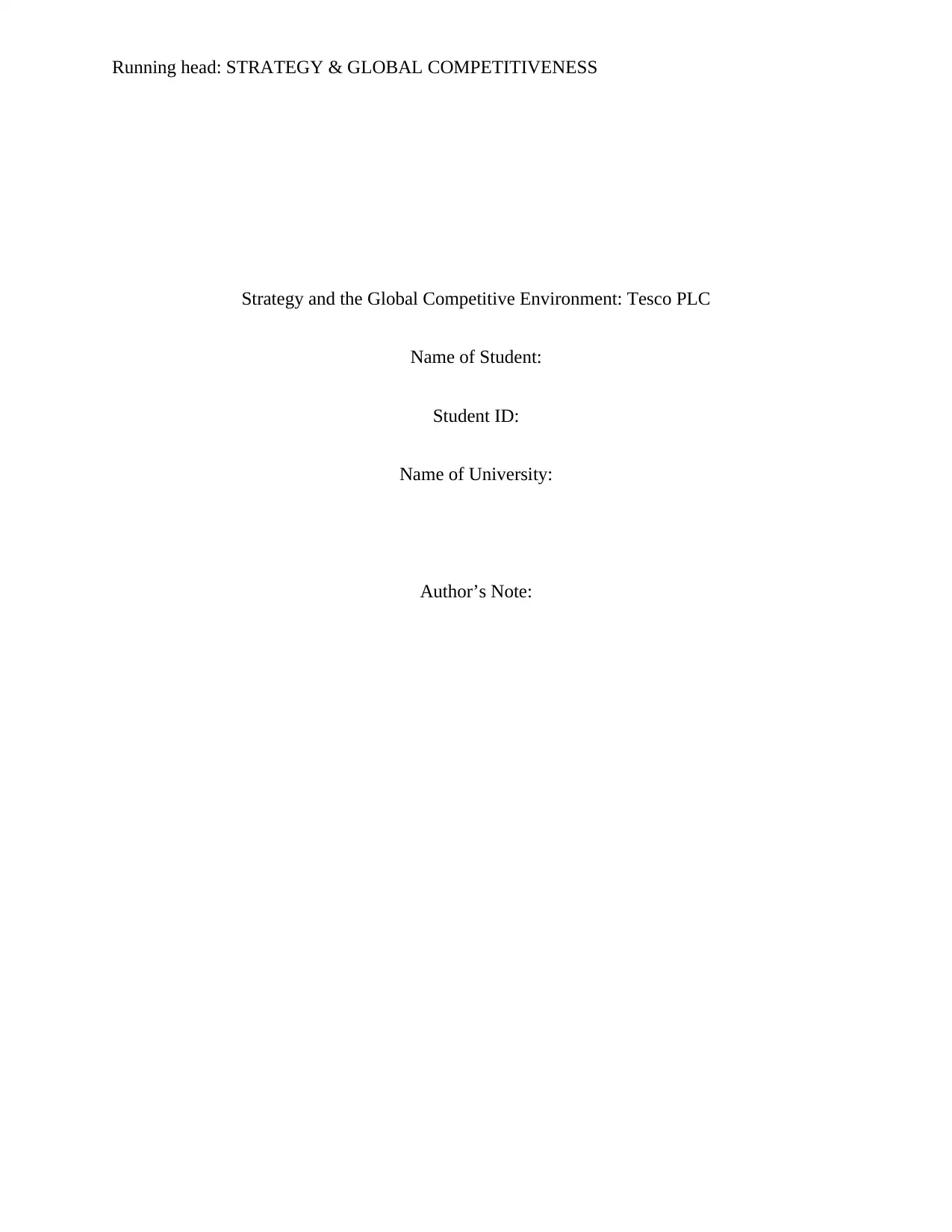
Running head: STRATEGY & GLOBAL COMPETITIVENESS
Strategy and the Global Competitive Environment: Tesco PLC
Name of Student:
Student ID:
Name of University:
Author’s Note:
Strategy and the Global Competitive Environment: Tesco PLC
Name of Student:
Student ID:
Name of University:
Author’s Note:
Secure Best Marks with AI Grader
Need help grading? Try our AI Grader for instant feedback on your assignments.
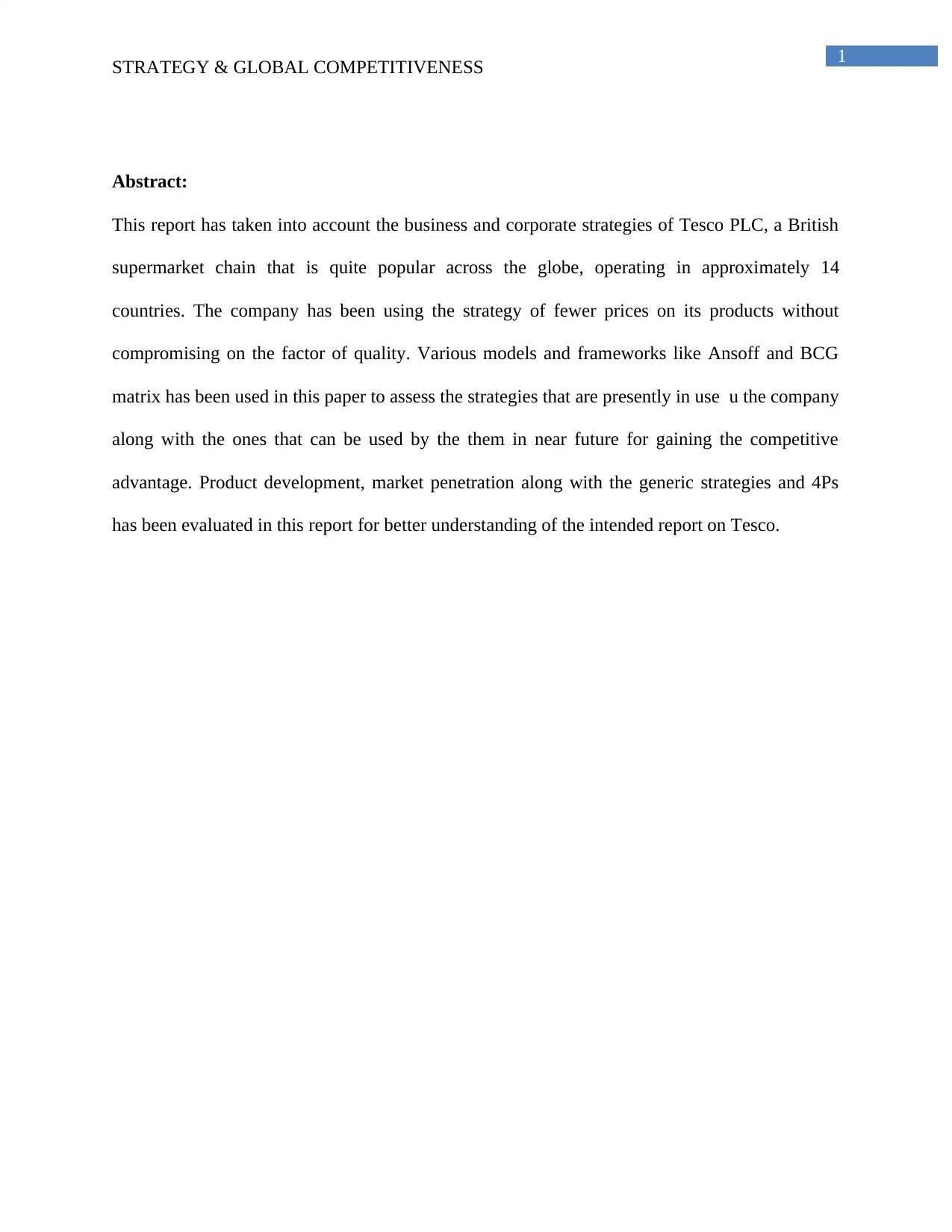
1
STRATEGY & GLOBAL COMPETITIVENESS
Abstract:
This report has taken into account the business and corporate strategies of Tesco PLC, a British
supermarket chain that is quite popular across the globe, operating in approximately 14
countries. The company has been using the strategy of fewer prices on its products without
compromising on the factor of quality. Various models and frameworks like Ansoff and BCG
matrix has been used in this paper to assess the strategies that are presently in use u the company
along with the ones that can be used by the them in near future for gaining the competitive
advantage. Product development, market penetration along with the generic strategies and 4Ps
has been evaluated in this report for better understanding of the intended report on Tesco.
STRATEGY & GLOBAL COMPETITIVENESS
Abstract:
This report has taken into account the business and corporate strategies of Tesco PLC, a British
supermarket chain that is quite popular across the globe, operating in approximately 14
countries. The company has been using the strategy of fewer prices on its products without
compromising on the factor of quality. Various models and frameworks like Ansoff and BCG
matrix has been used in this paper to assess the strategies that are presently in use u the company
along with the ones that can be used by the them in near future for gaining the competitive
advantage. Product development, market penetration along with the generic strategies and 4Ps
has been evaluated in this report for better understanding of the intended report on Tesco.
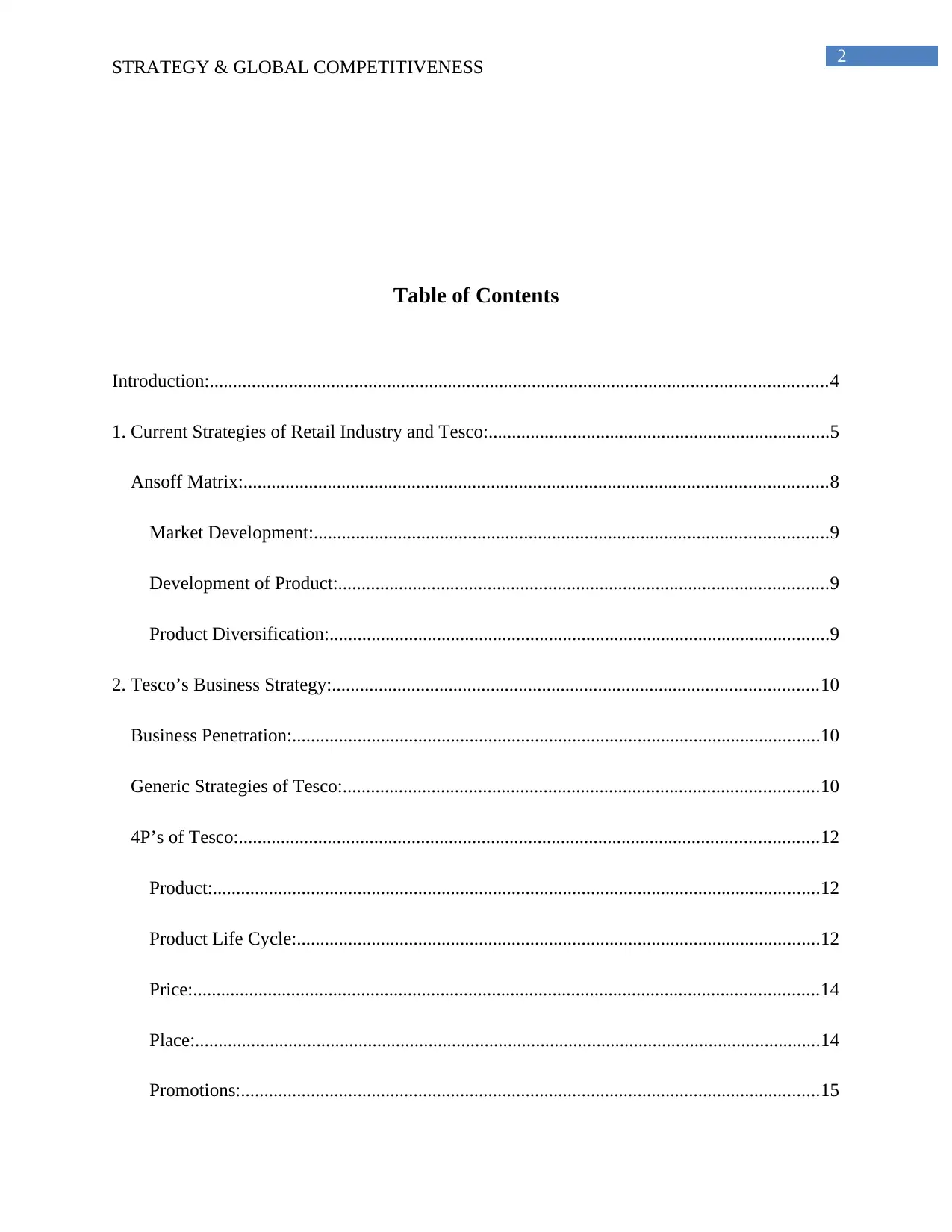
2
STRATEGY & GLOBAL COMPETITIVENESS
Table of Contents
Introduction:....................................................................................................................................4
1. Current Strategies of Retail Industry and Tesco:.........................................................................5
Ansoff Matrix:.............................................................................................................................8
Market Development:..............................................................................................................9
Development of Product:.........................................................................................................9
Product Diversification:...........................................................................................................9
2. Tesco’s Business Strategy:........................................................................................................10
Business Penetration:.................................................................................................................10
Generic Strategies of Tesco:......................................................................................................10
4P’s of Tesco:............................................................................................................................12
Product:..................................................................................................................................12
Product Life Cycle:................................................................................................................12
Price:......................................................................................................................................14
Place:......................................................................................................................................14
Promotions:............................................................................................................................15
STRATEGY & GLOBAL COMPETITIVENESS
Table of Contents
Introduction:....................................................................................................................................4
1. Current Strategies of Retail Industry and Tesco:.........................................................................5
Ansoff Matrix:.............................................................................................................................8
Market Development:..............................................................................................................9
Development of Product:.........................................................................................................9
Product Diversification:...........................................................................................................9
2. Tesco’s Business Strategy:........................................................................................................10
Business Penetration:.................................................................................................................10
Generic Strategies of Tesco:......................................................................................................10
4P’s of Tesco:............................................................................................................................12
Product:..................................................................................................................................12
Product Life Cycle:................................................................................................................12
Price:......................................................................................................................................14
Place:......................................................................................................................................14
Promotions:............................................................................................................................15
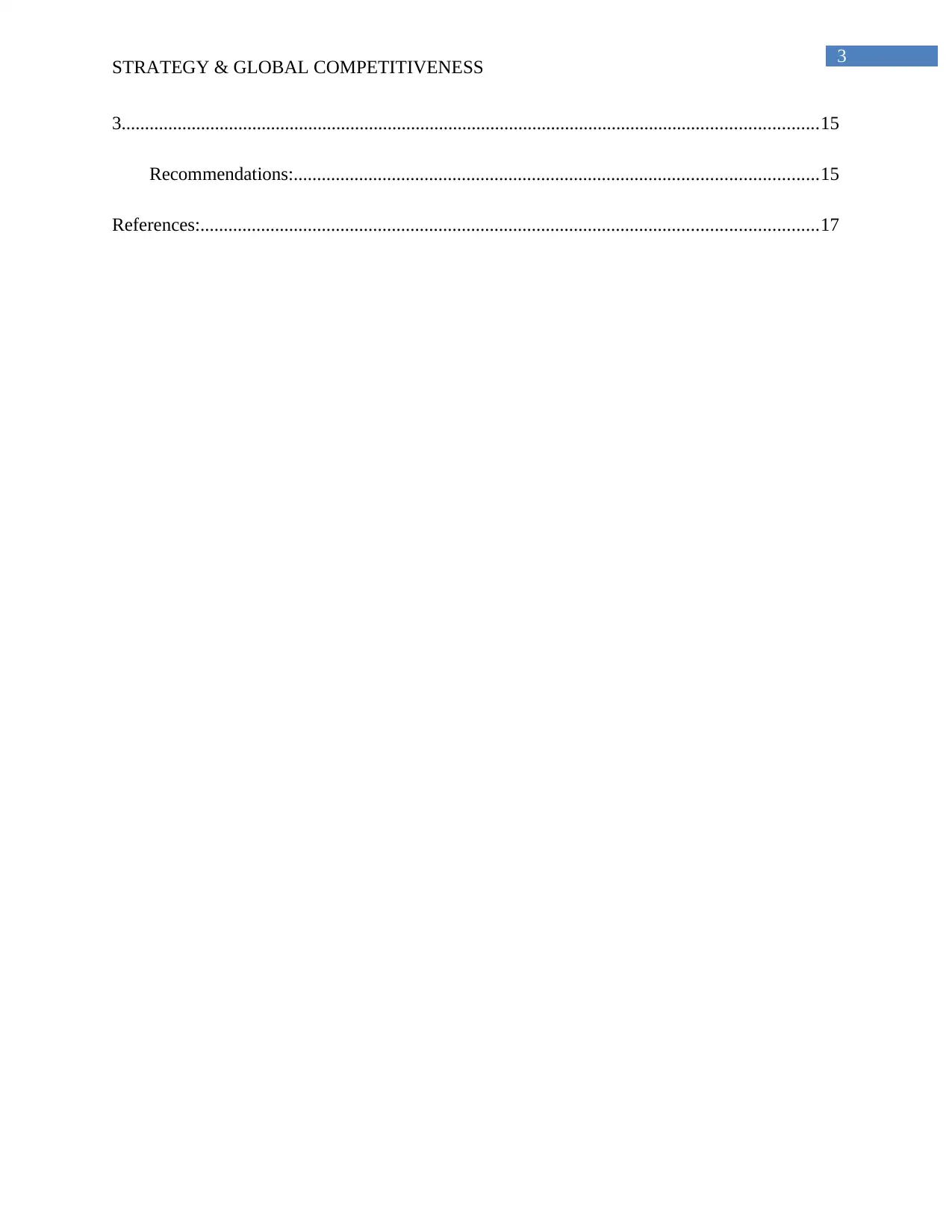
3
STRATEGY & GLOBAL COMPETITIVENESS
3.....................................................................................................................................................15
Recommendations:................................................................................................................15
References:....................................................................................................................................17
STRATEGY & GLOBAL COMPETITIVENESS
3.....................................................................................................................................................15
Recommendations:................................................................................................................15
References:....................................................................................................................................17
Secure Best Marks with AI Grader
Need help grading? Try our AI Grader for instant feedback on your assignments.
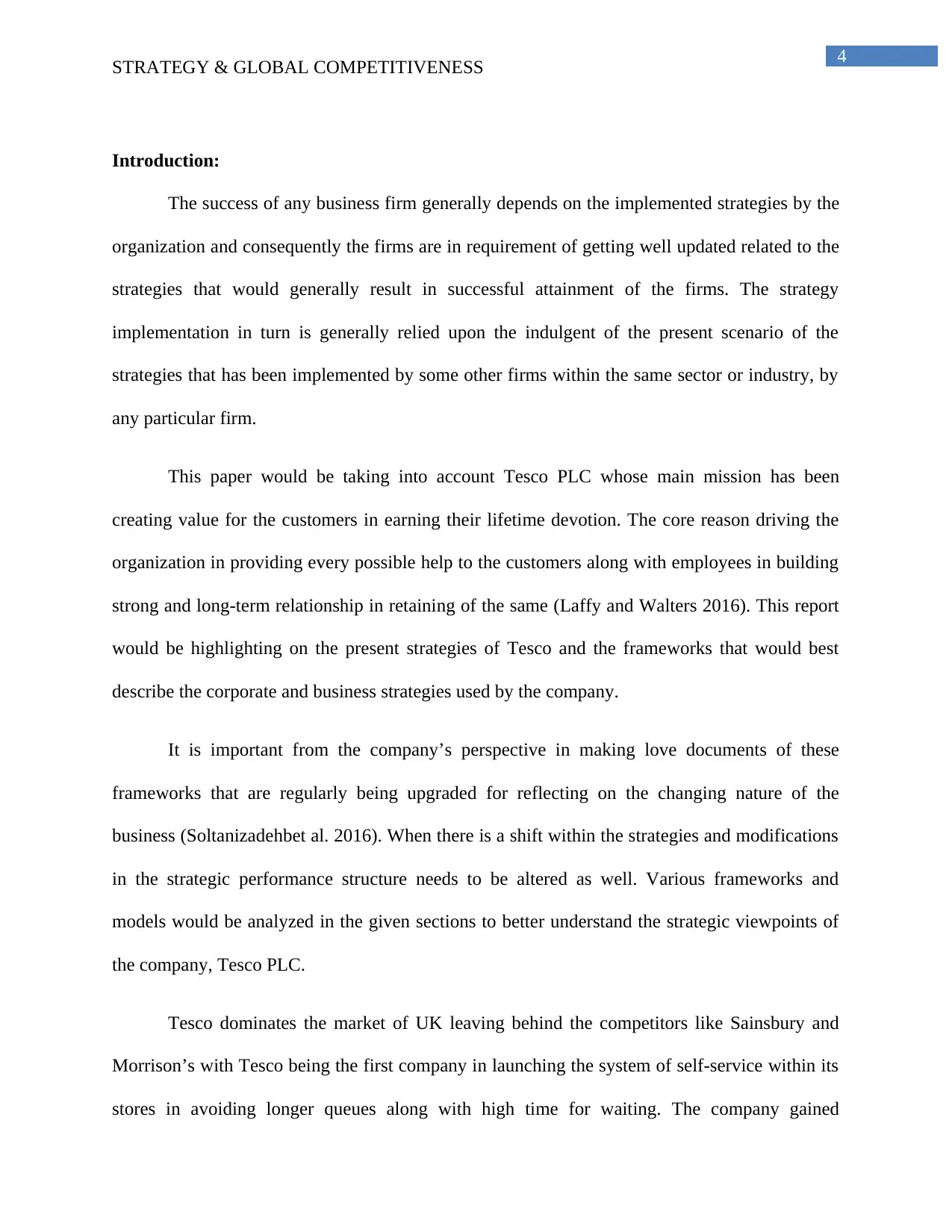
4
STRATEGY & GLOBAL COMPETITIVENESS
Introduction:
The success of any business firm generally depends on the implemented strategies by the
organization and consequently the firms are in requirement of getting well updated related to the
strategies that would generally result in successful attainment of the firms. The strategy
implementation in turn is generally relied upon the indulgent of the present scenario of the
strategies that has been implemented by some other firms within the same sector or industry, by
any particular firm.
This paper would be taking into account Tesco PLC whose main mission has been
creating value for the customers in earning their lifetime devotion. The core reason driving the
organization in providing every possible help to the customers along with employees in building
strong and long-term relationship in retaining of the same (Laffy and Walters 2016). This report
would be highlighting on the present strategies of Tesco and the frameworks that would best
describe the corporate and business strategies used by the company.
It is important from the company’s perspective in making love documents of these
frameworks that are regularly being upgraded for reflecting on the changing nature of the
business (Soltanizadehbet al. 2016). When there is a shift within the strategies and modifications
in the strategic performance structure needs to be altered as well. Various frameworks and
models would be analyzed in the given sections to better understand the strategic viewpoints of
the company, Tesco PLC.
Tesco dominates the market of UK leaving behind the competitors like Sainsbury and
Morrison’s with Tesco being the first company in launching the system of self-service within its
stores in avoiding longer queues along with high time for waiting. The company gained
STRATEGY & GLOBAL COMPETITIVENESS
Introduction:
The success of any business firm generally depends on the implemented strategies by the
organization and consequently the firms are in requirement of getting well updated related to the
strategies that would generally result in successful attainment of the firms. The strategy
implementation in turn is generally relied upon the indulgent of the present scenario of the
strategies that has been implemented by some other firms within the same sector or industry, by
any particular firm.
This paper would be taking into account Tesco PLC whose main mission has been
creating value for the customers in earning their lifetime devotion. The core reason driving the
organization in providing every possible help to the customers along with employees in building
strong and long-term relationship in retaining of the same (Laffy and Walters 2016). This report
would be highlighting on the present strategies of Tesco and the frameworks that would best
describe the corporate and business strategies used by the company.
It is important from the company’s perspective in making love documents of these
frameworks that are regularly being upgraded for reflecting on the changing nature of the
business (Soltanizadehbet al. 2016). When there is a shift within the strategies and modifications
in the strategic performance structure needs to be altered as well. Various frameworks and
models would be analyzed in the given sections to better understand the strategic viewpoints of
the company, Tesco PLC.
Tesco dominates the market of UK leaving behind the competitors like Sainsbury and
Morrison’s with Tesco being the first company in launching the system of self-service within its
stores in avoiding longer queues along with high time for waiting. The company gained
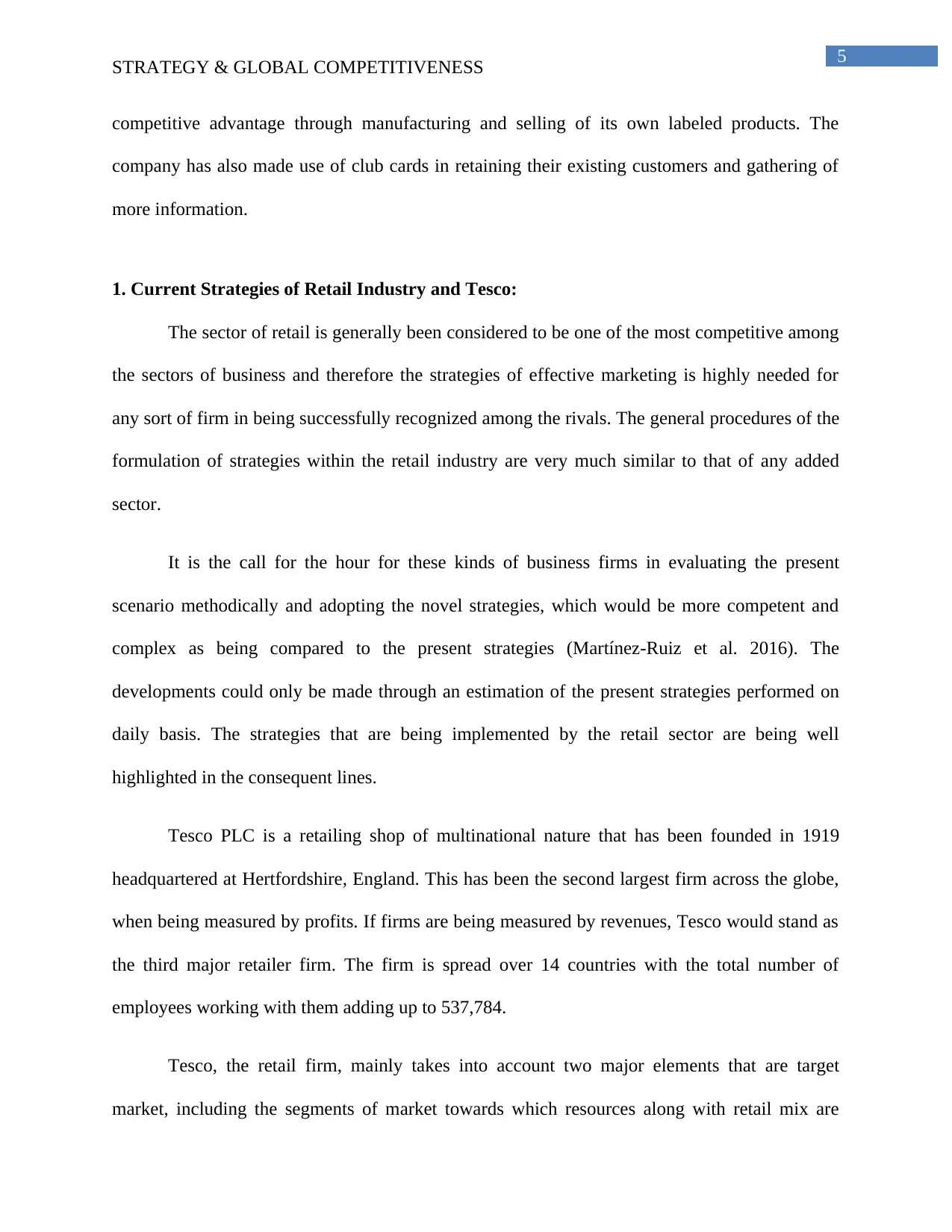
5
STRATEGY & GLOBAL COMPETITIVENESS
competitive advantage through manufacturing and selling of its own labeled products. The
company has also made use of club cards in retaining their existing customers and gathering of
more information.
1. Current Strategies of Retail Industry and Tesco:
The sector of retail is generally been considered to be one of the most competitive among
the sectors of business and therefore the strategies of effective marketing is highly needed for
any sort of firm in being successfully recognized among the rivals. The general procedures of the
formulation of strategies within the retail industry are very much similar to that of any added
sector.
It is the call for the hour for these kinds of business firms in evaluating the present
scenario methodically and adopting the novel strategies, which would be more competent and
complex as being compared to the present strategies (Martínez-Ruiz et al. 2016). The
developments could only be made through an estimation of the present strategies performed on
daily basis. The strategies that are being implemented by the retail sector are being well
highlighted in the consequent lines.
Tesco PLC is a retailing shop of multinational nature that has been founded in 1919
headquartered at Hertfordshire, England. This has been the second largest firm across the globe,
when being measured by profits. If firms are being measured by revenues, Tesco would stand as
the third major retailer firm. The firm is spread over 14 countries with the total number of
employees working with them adding up to 537,784.
Tesco, the retail firm, mainly takes into account two major elements that are target
market, including the segments of market towards which resources along with retail mix are
STRATEGY & GLOBAL COMPETITIVENESS
competitive advantage through manufacturing and selling of its own labeled products. The
company has also made use of club cards in retaining their existing customers and gathering of
more information.
1. Current Strategies of Retail Industry and Tesco:
The sector of retail is generally been considered to be one of the most competitive among
the sectors of business and therefore the strategies of effective marketing is highly needed for
any sort of firm in being successfully recognized among the rivals. The general procedures of the
formulation of strategies within the retail industry are very much similar to that of any added
sector.
It is the call for the hour for these kinds of business firms in evaluating the present
scenario methodically and adopting the novel strategies, which would be more competent and
complex as being compared to the present strategies (Martínez-Ruiz et al. 2016). The
developments could only be made through an estimation of the present strategies performed on
daily basis. The strategies that are being implemented by the retail sector are being well
highlighted in the consequent lines.
Tesco PLC is a retailing shop of multinational nature that has been founded in 1919
headquartered at Hertfordshire, England. This has been the second largest firm across the globe,
when being measured by profits. If firms are being measured by revenues, Tesco would stand as
the third major retailer firm. The firm is spread over 14 countries with the total number of
employees working with them adding up to 537,784.
Tesco, the retail firm, mainly takes into account two major elements that are target
market, including the segments of market towards which resources along with retail mix are
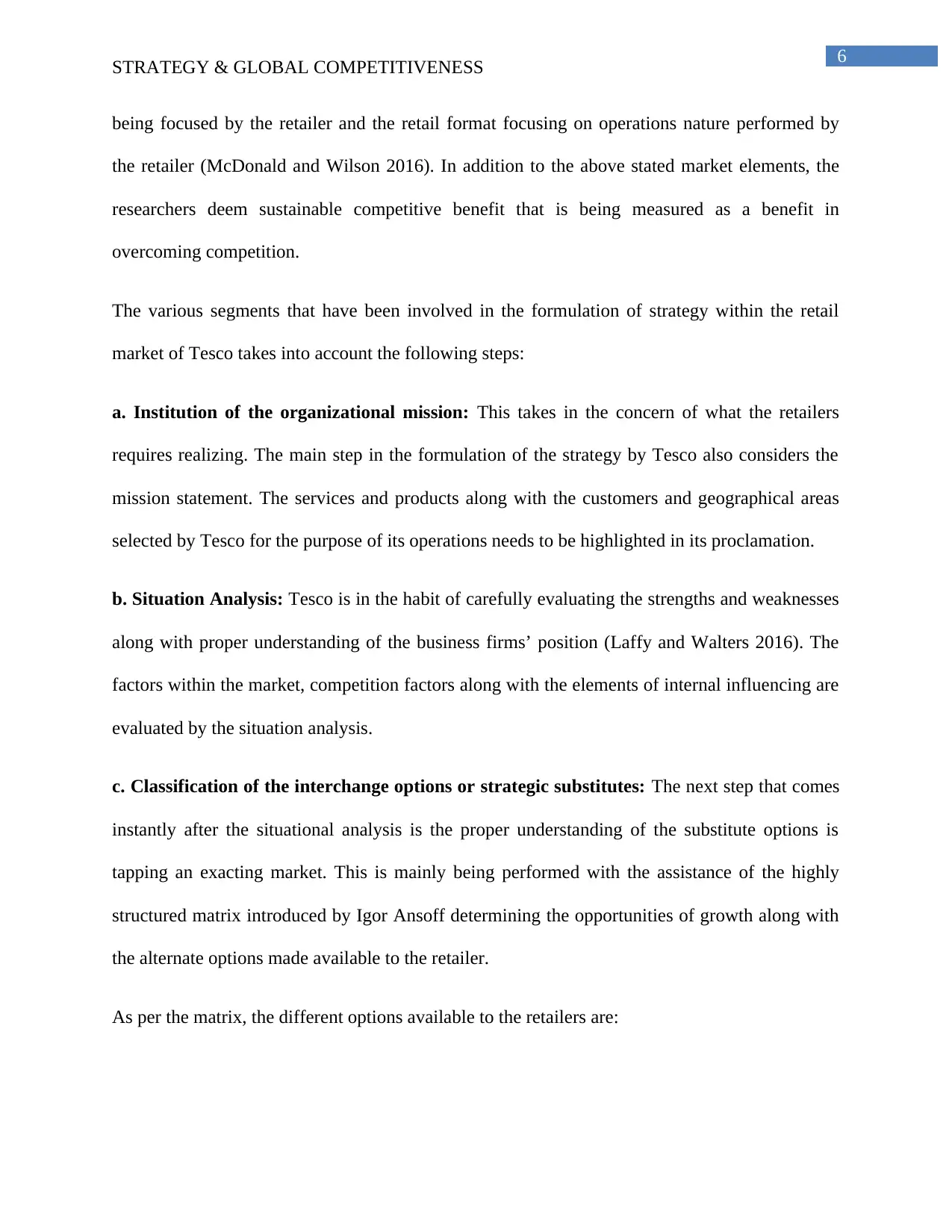
6
STRATEGY & GLOBAL COMPETITIVENESS
being focused by the retailer and the retail format focusing on operations nature performed by
the retailer (McDonald and Wilson 2016). In addition to the above stated market elements, the
researchers deem sustainable competitive benefit that is being measured as a benefit in
overcoming competition.
The various segments that have been involved in the formulation of strategy within the retail
market of Tesco takes into account the following steps:
a. Institution of the organizational mission: This takes in the concern of what the retailers
requires realizing. The main step in the formulation of the strategy by Tesco also considers the
mission statement. The services and products along with the customers and geographical areas
selected by Tesco for the purpose of its operations needs to be highlighted in its proclamation.
b. Situation Analysis: Tesco is in the habit of carefully evaluating the strengths and weaknesses
along with proper understanding of the business firms’ position (Laffy and Walters 2016). The
factors within the market, competition factors along with the elements of internal influencing are
evaluated by the situation analysis.
c. Classification of the interchange options or strategic substitutes: The next step that comes
instantly after the situational analysis is the proper understanding of the substitute options is
tapping an exacting market. This is mainly being performed with the assistance of the highly
structured matrix introduced by Igor Ansoff determining the opportunities of growth along with
the alternate options made available to the retailer.
As per the matrix, the different options available to the retailers are:
STRATEGY & GLOBAL COMPETITIVENESS
being focused by the retailer and the retail format focusing on operations nature performed by
the retailer (McDonald and Wilson 2016). In addition to the above stated market elements, the
researchers deem sustainable competitive benefit that is being measured as a benefit in
overcoming competition.
The various segments that have been involved in the formulation of strategy within the retail
market of Tesco takes into account the following steps:
a. Institution of the organizational mission: This takes in the concern of what the retailers
requires realizing. The main step in the formulation of the strategy by Tesco also considers the
mission statement. The services and products along with the customers and geographical areas
selected by Tesco for the purpose of its operations needs to be highlighted in its proclamation.
b. Situation Analysis: Tesco is in the habit of carefully evaluating the strengths and weaknesses
along with proper understanding of the business firms’ position (Laffy and Walters 2016). The
factors within the market, competition factors along with the elements of internal influencing are
evaluated by the situation analysis.
c. Classification of the interchange options or strategic substitutes: The next step that comes
instantly after the situational analysis is the proper understanding of the substitute options is
tapping an exacting market. This is mainly being performed with the assistance of the highly
structured matrix introduced by Igor Ansoff determining the opportunities of growth along with
the alternate options made available to the retailer.
As per the matrix, the different options available to the retailers are:
Paraphrase This Document
Need a fresh take? Get an instant paraphrase of this document with our AI Paraphraser
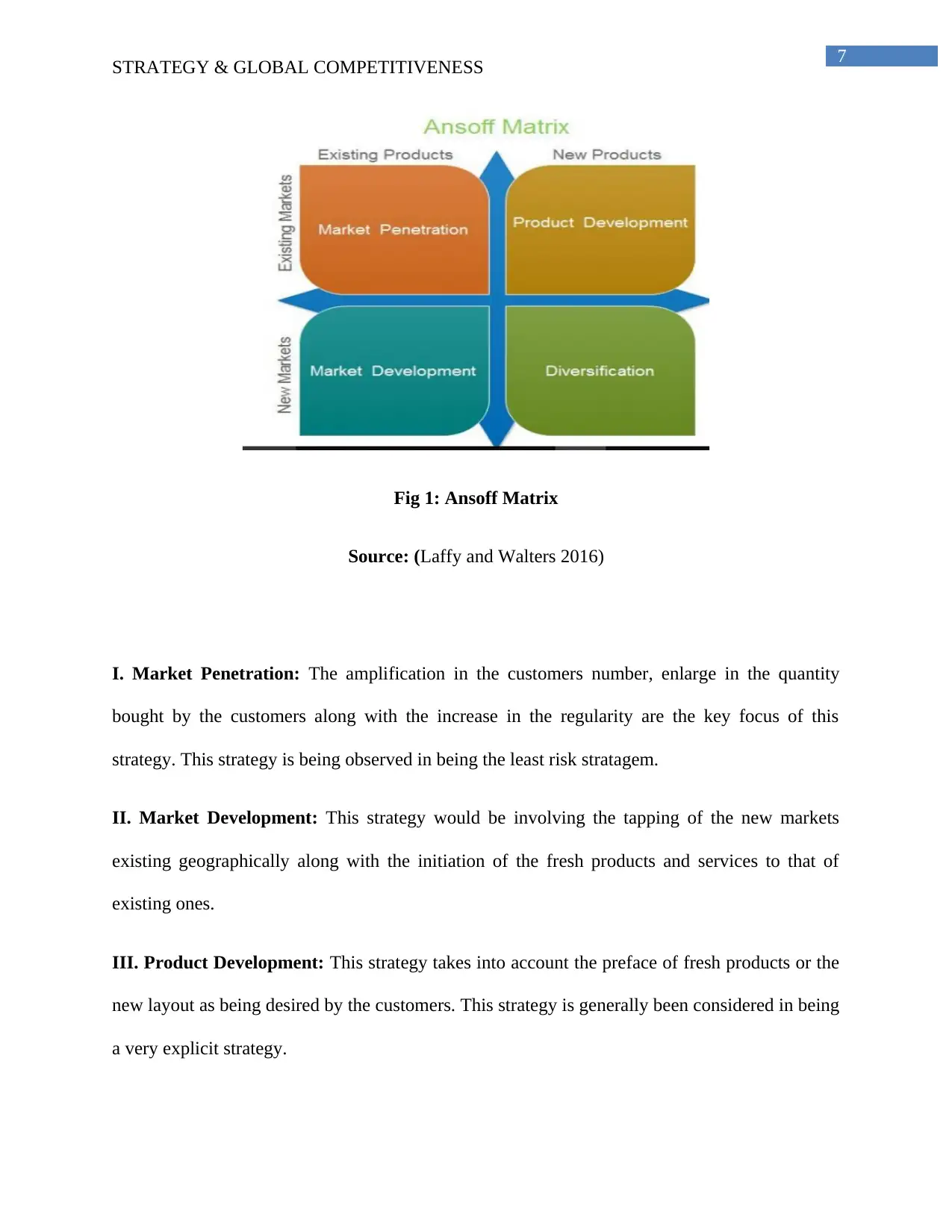
7
STRATEGY & GLOBAL COMPETITIVENESS
Fig 1: Ansoff Matrix
Source: (Laffy and Walters 2016)
I. Market Penetration: The amplification in the customers number, enlarge in the quantity
bought by the customers along with the increase in the regularity are the key focus of this
strategy. This strategy is being observed in being the least risk stratagem.
II. Market Development: This strategy would be involving the tapping of the new markets
existing geographically along with the initiation of the fresh products and services to that of
existing ones.
III. Product Development: This strategy takes into account the preface of fresh products or the
new layout as being desired by the customers. This strategy is generally been considered in being
a very explicit strategy.
STRATEGY & GLOBAL COMPETITIVENESS
Fig 1: Ansoff Matrix
Source: (Laffy and Walters 2016)
I. Market Penetration: The amplification in the customers number, enlarge in the quantity
bought by the customers along with the increase in the regularity are the key focus of this
strategy. This strategy is being observed in being the least risk stratagem.
II. Market Development: This strategy would be involving the tapping of the new markets
existing geographically along with the initiation of the fresh products and services to that of
existing ones.
III. Product Development: This strategy takes into account the preface of fresh products or the
new layout as being desired by the customers. This strategy is generally been considered in being
a very explicit strategy.
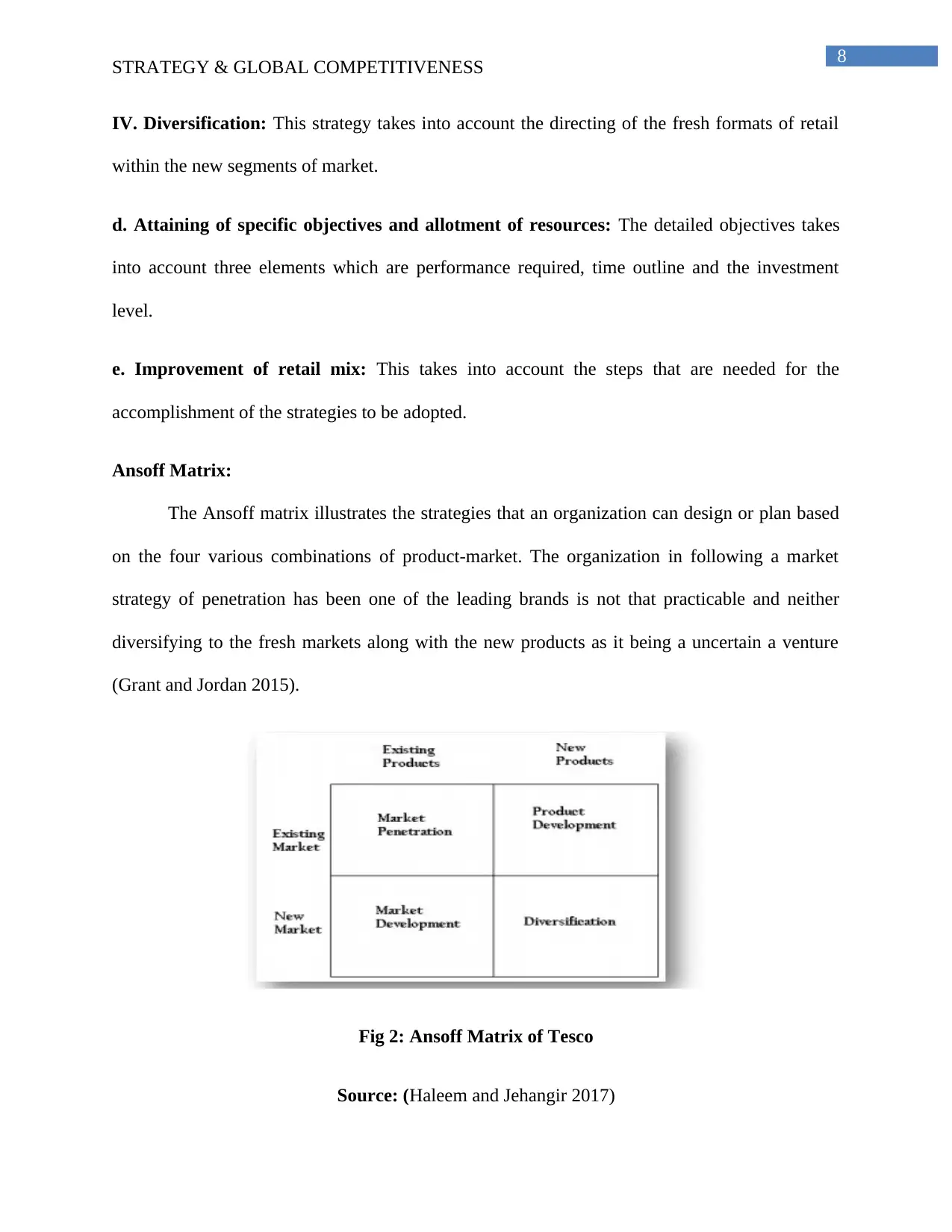
8
STRATEGY & GLOBAL COMPETITIVENESS
IV. Diversification: This strategy takes into account the directing of the fresh formats of retail
within the new segments of market.
d. Attaining of specific objectives and allotment of resources: The detailed objectives takes
into account three elements which are performance required, time outline and the investment
level.
e. Improvement of retail mix: This takes into account the steps that are needed for the
accomplishment of the strategies to be adopted.
Ansoff Matrix:
The Ansoff matrix illustrates the strategies that an organization can design or plan based
on the four various combinations of product-market. The organization in following a market
strategy of penetration has been one of the leading brands is not that practicable and neither
diversifying to the fresh markets along with the new products as it being a uncertain a venture
(Grant and Jordan 2015).
Fig 2: Ansoff Matrix of Tesco
Source: (Haleem and Jehangir 2017)
STRATEGY & GLOBAL COMPETITIVENESS
IV. Diversification: This strategy takes into account the directing of the fresh formats of retail
within the new segments of market.
d. Attaining of specific objectives and allotment of resources: The detailed objectives takes
into account three elements which are performance required, time outline and the investment
level.
e. Improvement of retail mix: This takes into account the steps that are needed for the
accomplishment of the strategies to be adopted.
Ansoff Matrix:
The Ansoff matrix illustrates the strategies that an organization can design or plan based
on the four various combinations of product-market. The organization in following a market
strategy of penetration has been one of the leading brands is not that practicable and neither
diversifying to the fresh markets along with the new products as it being a uncertain a venture
(Grant and Jordan 2015).
Fig 2: Ansoff Matrix of Tesco
Source: (Haleem and Jehangir 2017)
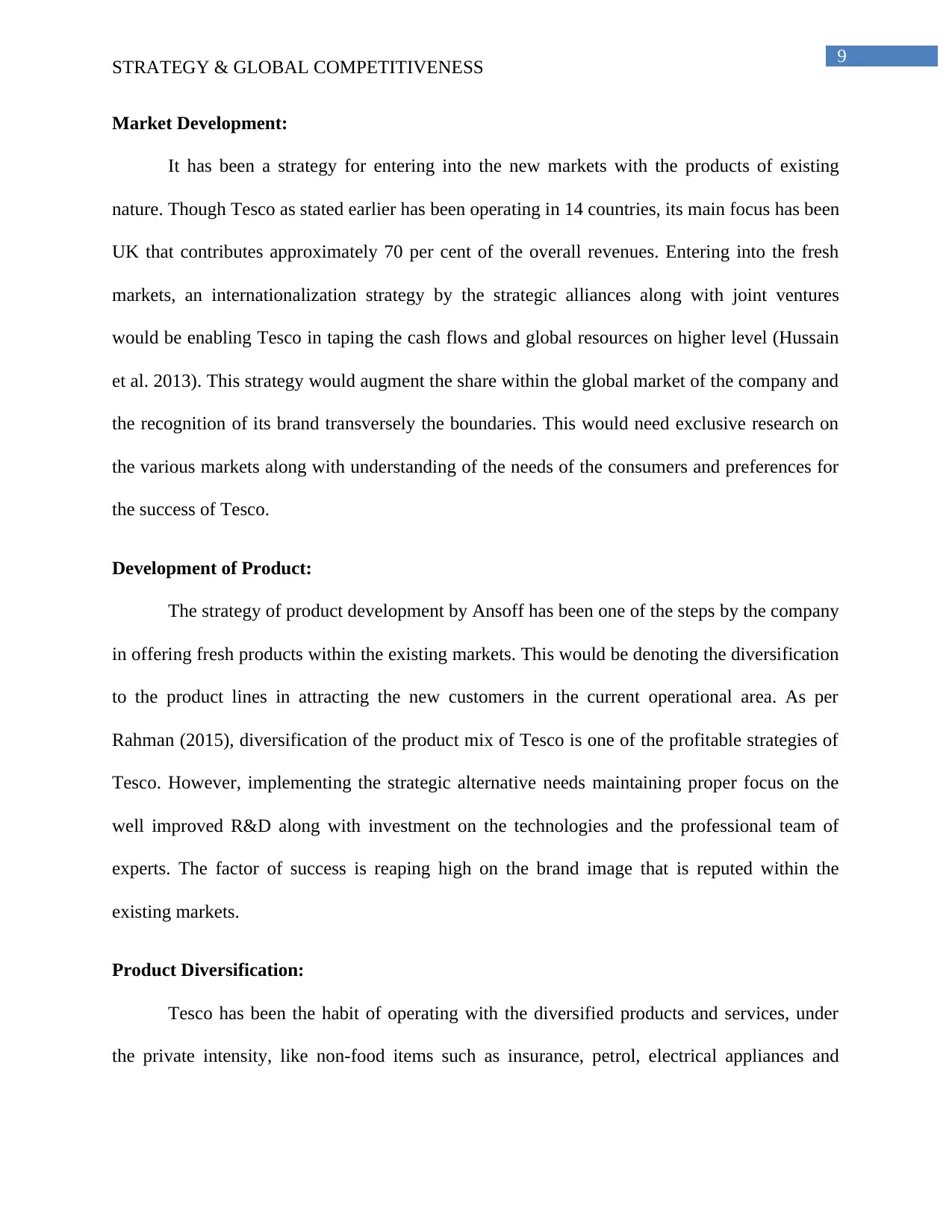
9
STRATEGY & GLOBAL COMPETITIVENESS
Market Development:
It has been a strategy for entering into the new markets with the products of existing
nature. Though Tesco as stated earlier has been operating in 14 countries, its main focus has been
UK that contributes approximately 70 per cent of the overall revenues. Entering into the fresh
markets, an internationalization strategy by the strategic alliances along with joint ventures
would be enabling Tesco in taping the cash flows and global resources on higher level (Hussain
et al. 2013). This strategy would augment the share within the global market of the company and
the recognition of its brand transversely the boundaries. This would need exclusive research on
the various markets along with understanding of the needs of the consumers and preferences for
the success of Tesco.
Development of Product:
The strategy of product development by Ansoff has been one of the steps by the company
in offering fresh products within the existing markets. This would be denoting the diversification
to the product lines in attracting the new customers in the current operational area. As per
Rahman (2015), diversification of the product mix of Tesco is one of the profitable strategies of
Tesco. However, implementing the strategic alternative needs maintaining proper focus on the
well improved R&D along with investment on the technologies and the professional team of
experts. The factor of success is reaping high on the brand image that is reputed within the
existing markets.
Product Diversification:
Tesco has been the habit of operating with the diversified products and services, under
the private intensity, like non-food items such as insurance, petrol, electrical appliances and
STRATEGY & GLOBAL COMPETITIVENESS
Market Development:
It has been a strategy for entering into the new markets with the products of existing
nature. Though Tesco as stated earlier has been operating in 14 countries, its main focus has been
UK that contributes approximately 70 per cent of the overall revenues. Entering into the fresh
markets, an internationalization strategy by the strategic alliances along with joint ventures
would be enabling Tesco in taping the cash flows and global resources on higher level (Hussain
et al. 2013). This strategy would augment the share within the global market of the company and
the recognition of its brand transversely the boundaries. This would need exclusive research on
the various markets along with understanding of the needs of the consumers and preferences for
the success of Tesco.
Development of Product:
The strategy of product development by Ansoff has been one of the steps by the company
in offering fresh products within the existing markets. This would be denoting the diversification
to the product lines in attracting the new customers in the current operational area. As per
Rahman (2015), diversification of the product mix of Tesco is one of the profitable strategies of
Tesco. However, implementing the strategic alternative needs maintaining proper focus on the
well improved R&D along with investment on the technologies and the professional team of
experts. The factor of success is reaping high on the brand image that is reputed within the
existing markets.
Product Diversification:
Tesco has been the habit of operating with the diversified products and services, under
the private intensity, like non-food items such as insurance, petrol, electrical appliances and
Secure Best Marks with AI Grader
Need help grading? Try our AI Grader for instant feedback on your assignments.
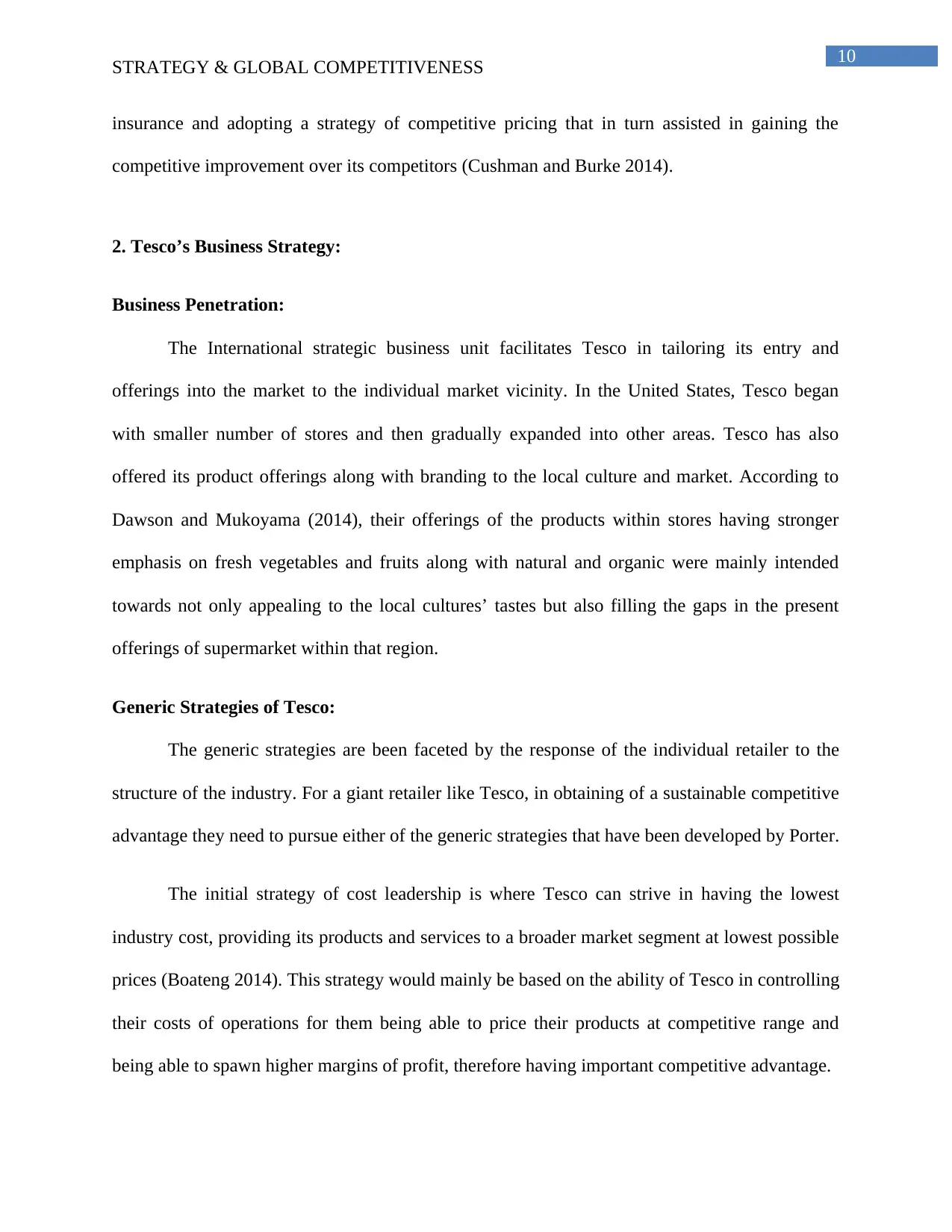
10
STRATEGY & GLOBAL COMPETITIVENESS
insurance and adopting a strategy of competitive pricing that in turn assisted in gaining the
competitive improvement over its competitors (Cushman and Burke 2014).
2. Tesco’s Business Strategy:
Business Penetration:
The International strategic business unit facilitates Tesco in tailoring its entry and
offerings into the market to the individual market vicinity. In the United States, Tesco began
with smaller number of stores and then gradually expanded into other areas. Tesco has also
offered its product offerings along with branding to the local culture and market. According to
Dawson and Mukoyama (2014), their offerings of the products within stores having stronger
emphasis on fresh vegetables and fruits along with natural and organic were mainly intended
towards not only appealing to the local cultures’ tastes but also filling the gaps in the present
offerings of supermarket within that region.
Generic Strategies of Tesco:
The generic strategies are been faceted by the response of the individual retailer to the
structure of the industry. For a giant retailer like Tesco, in obtaining of a sustainable competitive
advantage they need to pursue either of the generic strategies that have been developed by Porter.
The initial strategy of cost leadership is where Tesco can strive in having the lowest
industry cost, providing its products and services to a broader market segment at lowest possible
prices (Boateng 2014). This strategy would mainly be based on the ability of Tesco in controlling
their costs of operations for them being able to price their products at competitive range and
being able to spawn higher margins of profit, therefore having important competitive advantage.
STRATEGY & GLOBAL COMPETITIVENESS
insurance and adopting a strategy of competitive pricing that in turn assisted in gaining the
competitive improvement over its competitors (Cushman and Burke 2014).
2. Tesco’s Business Strategy:
Business Penetration:
The International strategic business unit facilitates Tesco in tailoring its entry and
offerings into the market to the individual market vicinity. In the United States, Tesco began
with smaller number of stores and then gradually expanded into other areas. Tesco has also
offered its product offerings along with branding to the local culture and market. According to
Dawson and Mukoyama (2014), their offerings of the products within stores having stronger
emphasis on fresh vegetables and fruits along with natural and organic were mainly intended
towards not only appealing to the local cultures’ tastes but also filling the gaps in the present
offerings of supermarket within that region.
Generic Strategies of Tesco:
The generic strategies are been faceted by the response of the individual retailer to the
structure of the industry. For a giant retailer like Tesco, in obtaining of a sustainable competitive
advantage they need to pursue either of the generic strategies that have been developed by Porter.
The initial strategy of cost leadership is where Tesco can strive in having the lowest
industry cost, providing its products and services to a broader market segment at lowest possible
prices (Boateng 2014). This strategy would mainly be based on the ability of Tesco in controlling
their costs of operations for them being able to price their products at competitive range and
being able to spawn higher margins of profit, therefore having important competitive advantage.
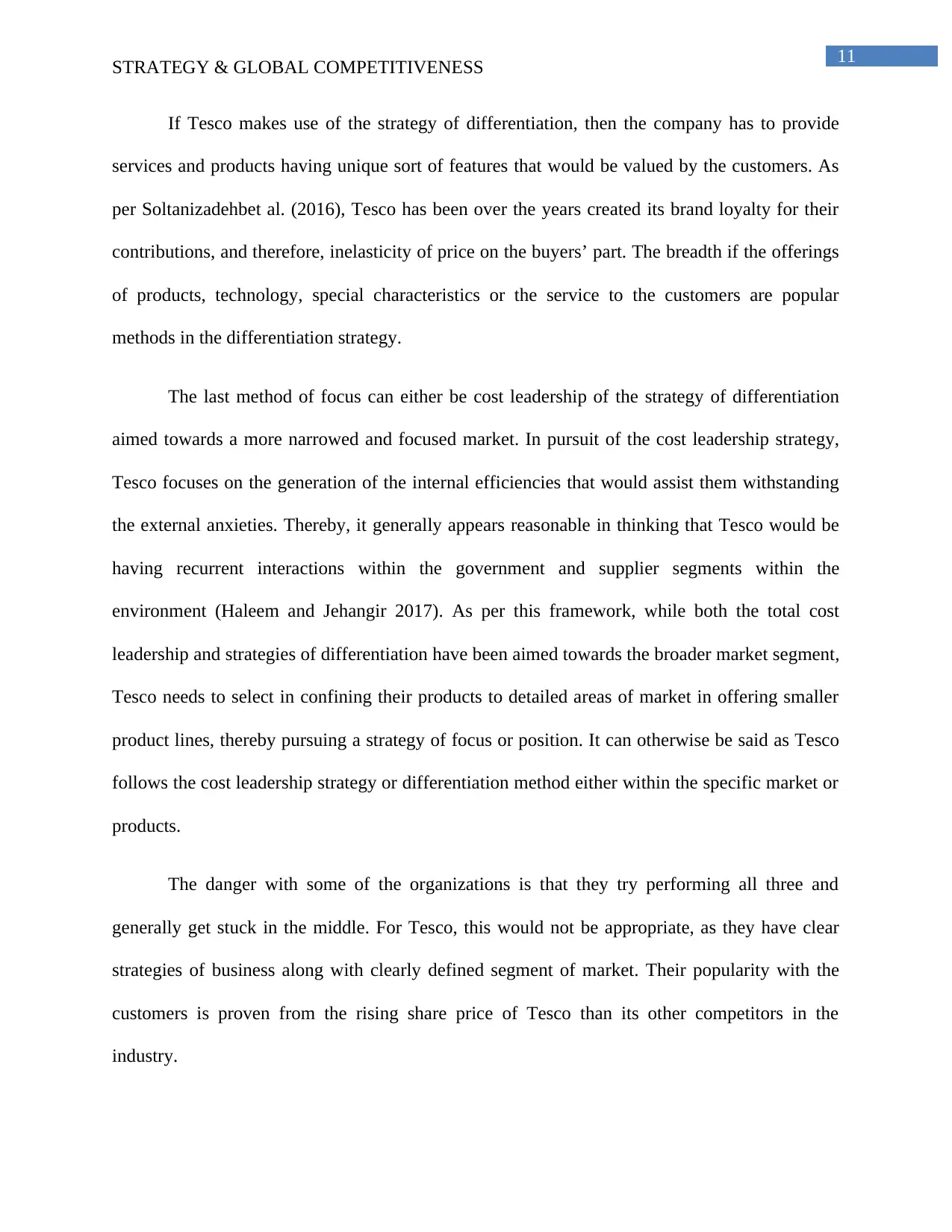
11
STRATEGY & GLOBAL COMPETITIVENESS
If Tesco makes use of the strategy of differentiation, then the company has to provide
services and products having unique sort of features that would be valued by the customers. As
per Soltanizadehbet al. (2016), Tesco has been over the years created its brand loyalty for their
contributions, and therefore, inelasticity of price on the buyers’ part. The breadth if the offerings
of products, technology, special characteristics or the service to the customers are popular
methods in the differentiation strategy.
The last method of focus can either be cost leadership of the strategy of differentiation
aimed towards a more narrowed and focused market. In pursuit of the cost leadership strategy,
Tesco focuses on the generation of the internal efficiencies that would assist them withstanding
the external anxieties. Thereby, it generally appears reasonable in thinking that Tesco would be
having recurrent interactions within the government and supplier segments within the
environment (Haleem and Jehangir 2017). As per this framework, while both the total cost
leadership and strategies of differentiation have been aimed towards the broader market segment,
Tesco needs to select in confining their products to detailed areas of market in offering smaller
product lines, thereby pursuing a strategy of focus or position. It can otherwise be said as Tesco
follows the cost leadership strategy or differentiation method either within the specific market or
products.
The danger with some of the organizations is that they try performing all three and
generally get stuck in the middle. For Tesco, this would not be appropriate, as they have clear
strategies of business along with clearly defined segment of market. Their popularity with the
customers is proven from the rising share price of Tesco than its other competitors in the
industry.
STRATEGY & GLOBAL COMPETITIVENESS
If Tesco makes use of the strategy of differentiation, then the company has to provide
services and products having unique sort of features that would be valued by the customers. As
per Soltanizadehbet al. (2016), Tesco has been over the years created its brand loyalty for their
contributions, and therefore, inelasticity of price on the buyers’ part. The breadth if the offerings
of products, technology, special characteristics or the service to the customers are popular
methods in the differentiation strategy.
The last method of focus can either be cost leadership of the strategy of differentiation
aimed towards a more narrowed and focused market. In pursuit of the cost leadership strategy,
Tesco focuses on the generation of the internal efficiencies that would assist them withstanding
the external anxieties. Thereby, it generally appears reasonable in thinking that Tesco would be
having recurrent interactions within the government and supplier segments within the
environment (Haleem and Jehangir 2017). As per this framework, while both the total cost
leadership and strategies of differentiation have been aimed towards the broader market segment,
Tesco needs to select in confining their products to detailed areas of market in offering smaller
product lines, thereby pursuing a strategy of focus or position. It can otherwise be said as Tesco
follows the cost leadership strategy or differentiation method either within the specific market or
products.
The danger with some of the organizations is that they try performing all three and
generally get stuck in the middle. For Tesco, this would not be appropriate, as they have clear
strategies of business along with clearly defined segment of market. Their popularity with the
customers is proven from the rising share price of Tesco than its other competitors in the
industry.
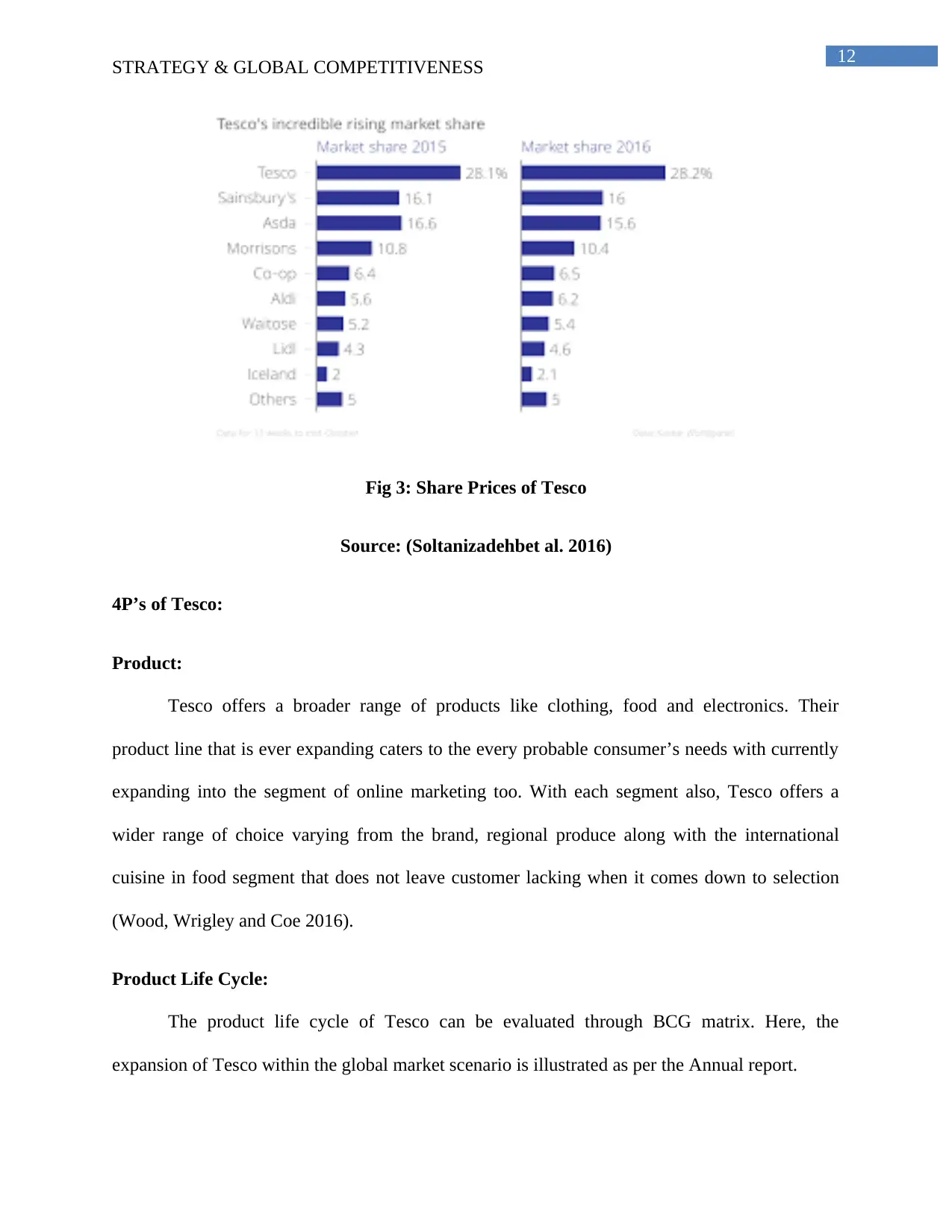
12
STRATEGY & GLOBAL COMPETITIVENESS
Fig 3: Share Prices of Tesco
Source: (Soltanizadehbet al. 2016)
4P’s of Tesco:
Product:
Tesco offers a broader range of products like clothing, food and electronics. Their
product line that is ever expanding caters to the every probable consumer’s needs with currently
expanding into the segment of online marketing too. With each segment also, Tesco offers a
wider range of choice varying from the brand, regional produce along with the international
cuisine in food segment that does not leave customer lacking when it comes down to selection
(Wood, Wrigley and Coe 2016).
Product Life Cycle:
The product life cycle of Tesco can be evaluated through BCG matrix. Here, the
expansion of Tesco within the global market scenario is illustrated as per the Annual report.
STRATEGY & GLOBAL COMPETITIVENESS
Fig 3: Share Prices of Tesco
Source: (Soltanizadehbet al. 2016)
4P’s of Tesco:
Product:
Tesco offers a broader range of products like clothing, food and electronics. Their
product line that is ever expanding caters to the every probable consumer’s needs with currently
expanding into the segment of online marketing too. With each segment also, Tesco offers a
wider range of choice varying from the brand, regional produce along with the international
cuisine in food segment that does not leave customer lacking when it comes down to selection
(Wood, Wrigley and Coe 2016).
Product Life Cycle:
The product life cycle of Tesco can be evaluated through BCG matrix. Here, the
expansion of Tesco within the global market scenario is illustrated as per the Annual report.
Paraphrase This Document
Need a fresh take? Get an instant paraphrase of this document with our AI Paraphraser

13
STRATEGY & GLOBAL COMPETITIVENESS
Fig 4: BCG Matrix
Source: (Pilarczyk and Stefanska 2013)
Star Product:
It generally indicates the share of the market along with high growth. The UK market has
been stated star for Tesco Petrol. The profit escalates to 12 per cent with the sale of petrol.
Question Mark Product:
It generally illustrates low and high growth market share. In the Asian markets people
have been buying the products of Tesco but the prices of shares are low for stiff competition
within the telecom industry.
Cash Cow Product:
In this segment there is lower growth but higher share of market. It is generally seen
within the European market where Tesco has certain competitors, however for its brand name
Tesco’s process of shares are high (Pilarczyk and Stefanska 2013).
STRATEGY & GLOBAL COMPETITIVENESS
Fig 4: BCG Matrix
Source: (Pilarczyk and Stefanska 2013)
Star Product:
It generally indicates the share of the market along with high growth. The UK market has
been stated star for Tesco Petrol. The profit escalates to 12 per cent with the sale of petrol.
Question Mark Product:
It generally illustrates low and high growth market share. In the Asian markets people
have been buying the products of Tesco but the prices of shares are low for stiff competition
within the telecom industry.
Cash Cow Product:
In this segment there is lower growth but higher share of market. It is generally seen
within the European market where Tesco has certain competitors, however for its brand name
Tesco’s process of shares are high (Pilarczyk and Stefanska 2013).
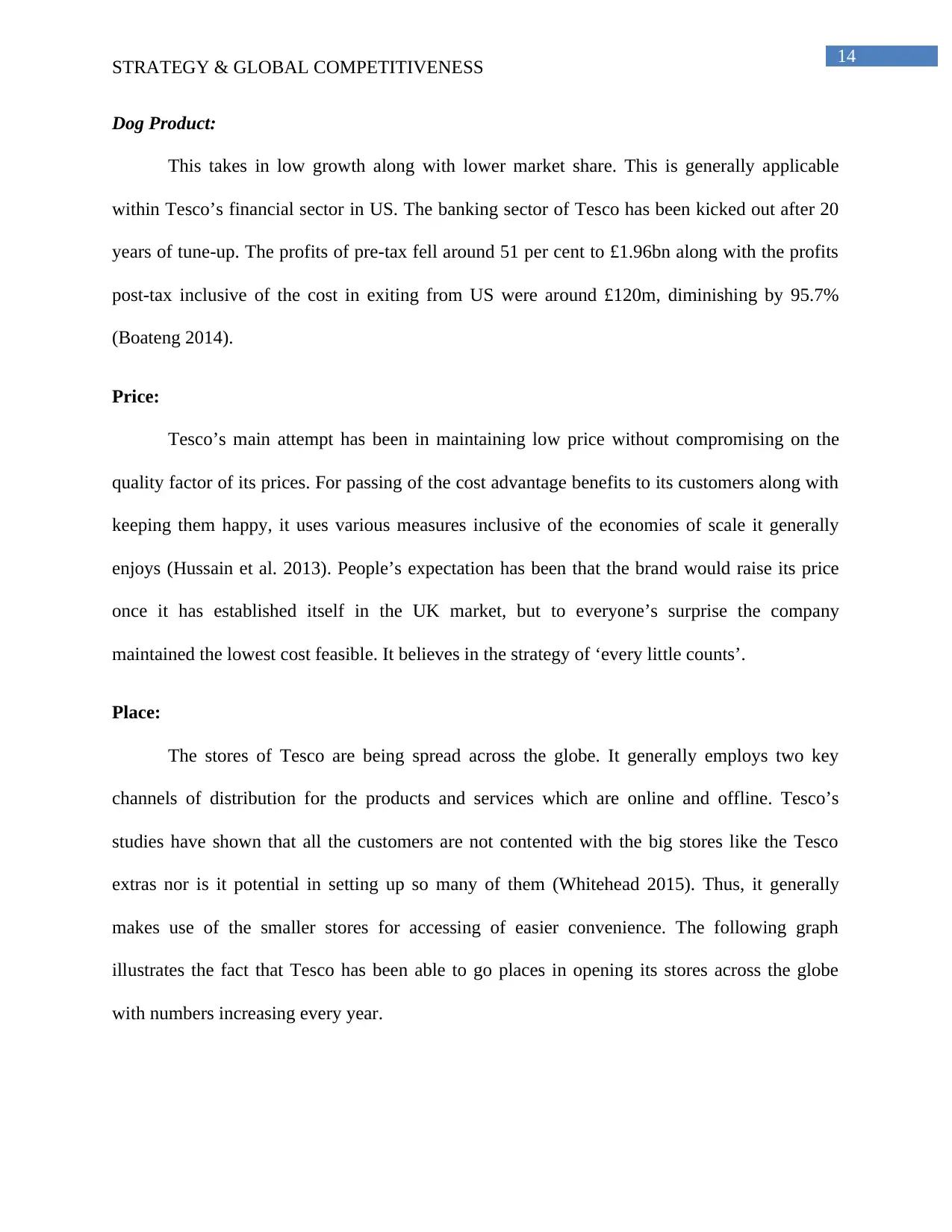
14
STRATEGY & GLOBAL COMPETITIVENESS
Dog Product:
This takes in low growth along with lower market share. This is generally applicable
within Tesco’s financial sector in US. The banking sector of Tesco has been kicked out after 20
years of tune-up. The profits of pre-tax fell around 51 per cent to £1.96bn along with the profits
post-tax inclusive of the cost in exiting from US were around £120m, diminishing by 95.7%
(Boateng 2014).
Price:
Tesco’s main attempt has been in maintaining low price without compromising on the
quality factor of its prices. For passing of the cost advantage benefits to its customers along with
keeping them happy, it uses various measures inclusive of the economies of scale it generally
enjoys (Hussain et al. 2013). People’s expectation has been that the brand would raise its price
once it has established itself in the UK market, but to everyone’s surprise the company
maintained the lowest cost feasible. It believes in the strategy of ‘every little counts’.
Place:
The stores of Tesco are being spread across the globe. It generally employs two key
channels of distribution for the products and services which are online and offline. Tesco’s
studies have shown that all the customers are not contented with the big stores like the Tesco
extras nor is it potential in setting up so many of them (Whitehead 2015). Thus, it generally
makes use of the smaller stores for accessing of easier convenience. The following graph
illustrates the fact that Tesco has been able to go places in opening its stores across the globe
with numbers increasing every year.
STRATEGY & GLOBAL COMPETITIVENESS
Dog Product:
This takes in low growth along with lower market share. This is generally applicable
within Tesco’s financial sector in US. The banking sector of Tesco has been kicked out after 20
years of tune-up. The profits of pre-tax fell around 51 per cent to £1.96bn along with the profits
post-tax inclusive of the cost in exiting from US were around £120m, diminishing by 95.7%
(Boateng 2014).
Price:
Tesco’s main attempt has been in maintaining low price without compromising on the
quality factor of its prices. For passing of the cost advantage benefits to its customers along with
keeping them happy, it uses various measures inclusive of the economies of scale it generally
enjoys (Hussain et al. 2013). People’s expectation has been that the brand would raise its price
once it has established itself in the UK market, but to everyone’s surprise the company
maintained the lowest cost feasible. It believes in the strategy of ‘every little counts’.
Place:
The stores of Tesco are being spread across the globe. It generally employs two key
channels of distribution for the products and services which are online and offline. Tesco’s
studies have shown that all the customers are not contented with the big stores like the Tesco
extras nor is it potential in setting up so many of them (Whitehead 2015). Thus, it generally
makes use of the smaller stores for accessing of easier convenience. The following graph
illustrates the fact that Tesco has been able to go places in opening its stores across the globe
with numbers increasing every year.
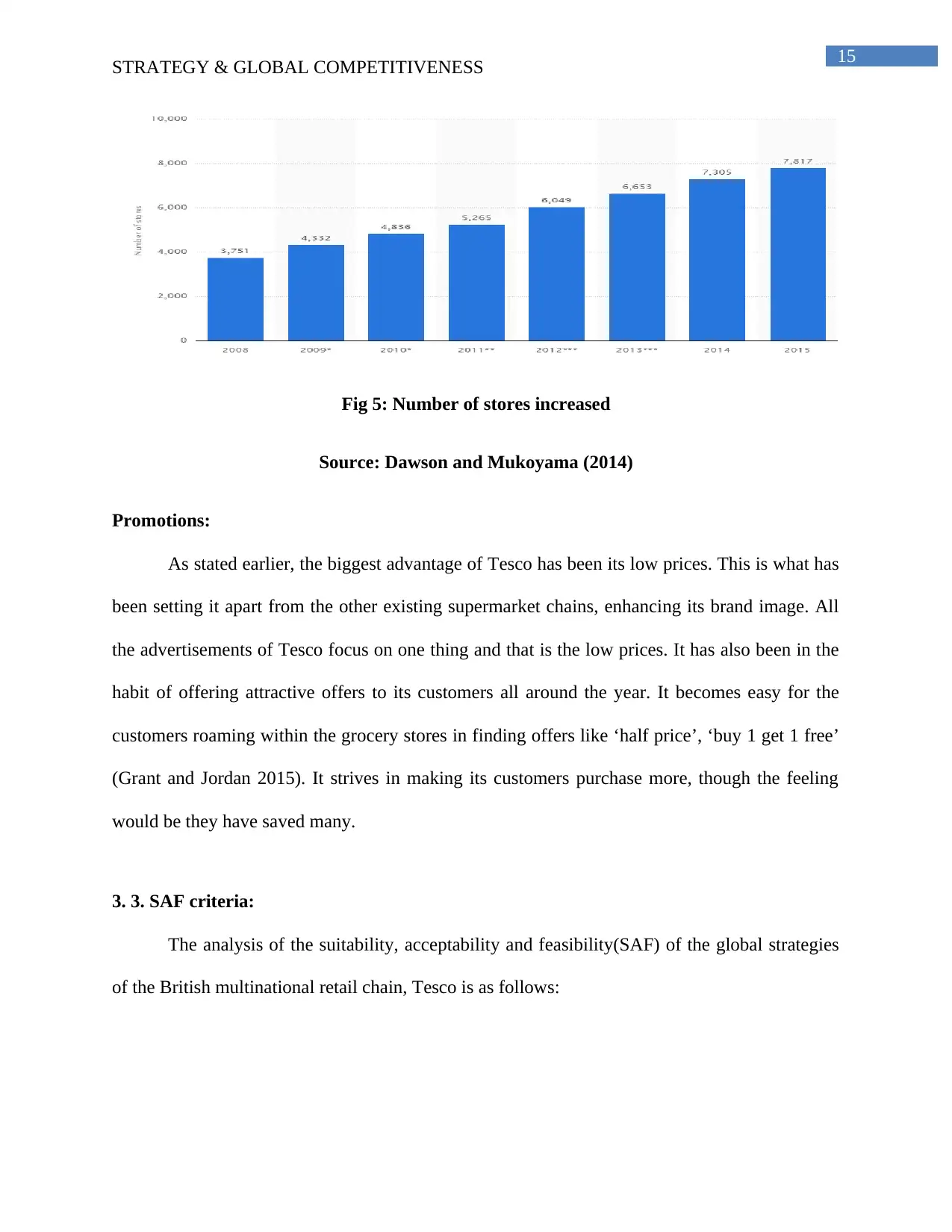
15
STRATEGY & GLOBAL COMPETITIVENESS
Fig 5: Number of stores increased
Source: Dawson and Mukoyama (2014)
Promotions:
As stated earlier, the biggest advantage of Tesco has been its low prices. This is what has
been setting it apart from the other existing supermarket chains, enhancing its brand image. All
the advertisements of Tesco focus on one thing and that is the low prices. It has also been in the
habit of offering attractive offers to its customers all around the year. It becomes easy for the
customers roaming within the grocery stores in finding offers like ‘half price’, ‘buy 1 get 1 free’
(Grant and Jordan 2015). It strives in making its customers purchase more, though the feeling
would be they have saved many.
3. 3. SAF criteria:
The analysis of the suitability, acceptability and feasibility(SAF) of the global strategies
of the British multinational retail chain, Tesco is as follows:
STRATEGY & GLOBAL COMPETITIVENESS
Fig 5: Number of stores increased
Source: Dawson and Mukoyama (2014)
Promotions:
As stated earlier, the biggest advantage of Tesco has been its low prices. This is what has
been setting it apart from the other existing supermarket chains, enhancing its brand image. All
the advertisements of Tesco focus on one thing and that is the low prices. It has also been in the
habit of offering attractive offers to its customers all around the year. It becomes easy for the
customers roaming within the grocery stores in finding offers like ‘half price’, ‘buy 1 get 1 free’
(Grant and Jordan 2015). It strives in making its customers purchase more, though the feeling
would be they have saved many.
3. 3. SAF criteria:
The analysis of the suitability, acceptability and feasibility(SAF) of the global strategies
of the British multinational retail chain, Tesco is as follows:
Secure Best Marks with AI Grader
Need help grading? Try our AI Grader for instant feedback on your assignments.
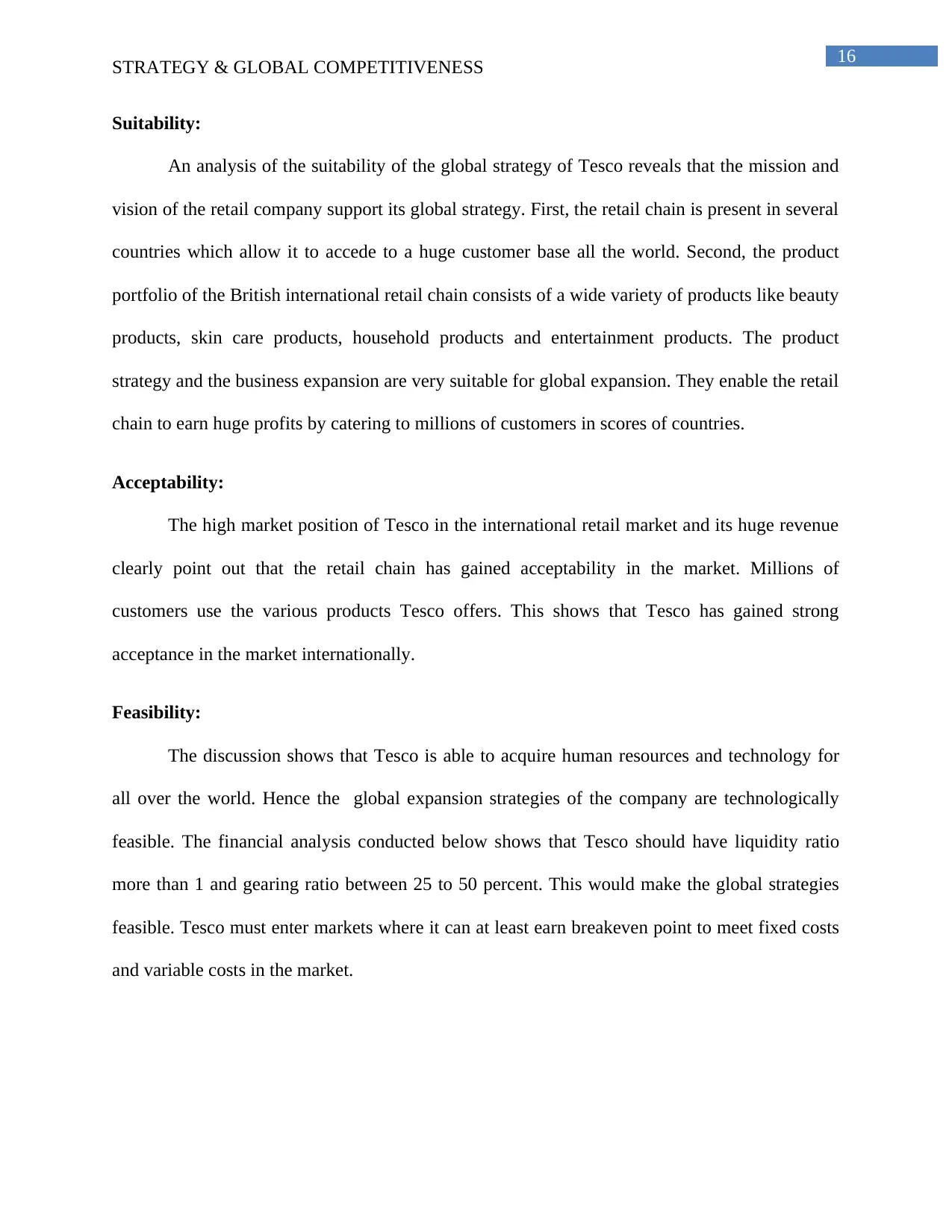
16
STRATEGY & GLOBAL COMPETITIVENESS
Suitability:
An analysis of the suitability of the global strategy of Tesco reveals that the mission and
vision of the retail company support its global strategy. First, the retail chain is present in several
countries which allow it to accede to a huge customer base all the world. Second, the product
portfolio of the British international retail chain consists of a wide variety of products like beauty
products, skin care products, household products and entertainment products. The product
strategy and the business expansion are very suitable for global expansion. They enable the retail
chain to earn huge profits by catering to millions of customers in scores of countries.
Acceptability:
The high market position of Tesco in the international retail market and its huge revenue
clearly point out that the retail chain has gained acceptability in the market. Millions of
customers use the various products Tesco offers. This shows that Tesco has gained strong
acceptance in the market internationally.
Feasibility:
The discussion shows that Tesco is able to acquire human resources and technology for
all over the world. Hence the global expansion strategies of the company are technologically
feasible. The financial analysis conducted below shows that Tesco should have liquidity ratio
more than 1 and gearing ratio between 25 to 50 percent. This would make the global strategies
feasible. Tesco must enter markets where it can at least earn breakeven point to meet fixed costs
and variable costs in the market.
STRATEGY & GLOBAL COMPETITIVENESS
Suitability:
An analysis of the suitability of the global strategy of Tesco reveals that the mission and
vision of the retail company support its global strategy. First, the retail chain is present in several
countries which allow it to accede to a huge customer base all the world. Second, the product
portfolio of the British international retail chain consists of a wide variety of products like beauty
products, skin care products, household products and entertainment products. The product
strategy and the business expansion are very suitable for global expansion. They enable the retail
chain to earn huge profits by catering to millions of customers in scores of countries.
Acceptability:
The high market position of Tesco in the international retail market and its huge revenue
clearly point out that the retail chain has gained acceptability in the market. Millions of
customers use the various products Tesco offers. This shows that Tesco has gained strong
acceptance in the market internationally.
Feasibility:
The discussion shows that Tesco is able to acquire human resources and technology for
all over the world. Hence the global expansion strategies of the company are technologically
feasible. The financial analysis conducted below shows that Tesco should have liquidity ratio
more than 1 and gearing ratio between 25 to 50 percent. This would make the global strategies
feasible. Tesco must enter markets where it can at least earn breakeven point to meet fixed costs
and variable costs in the market.
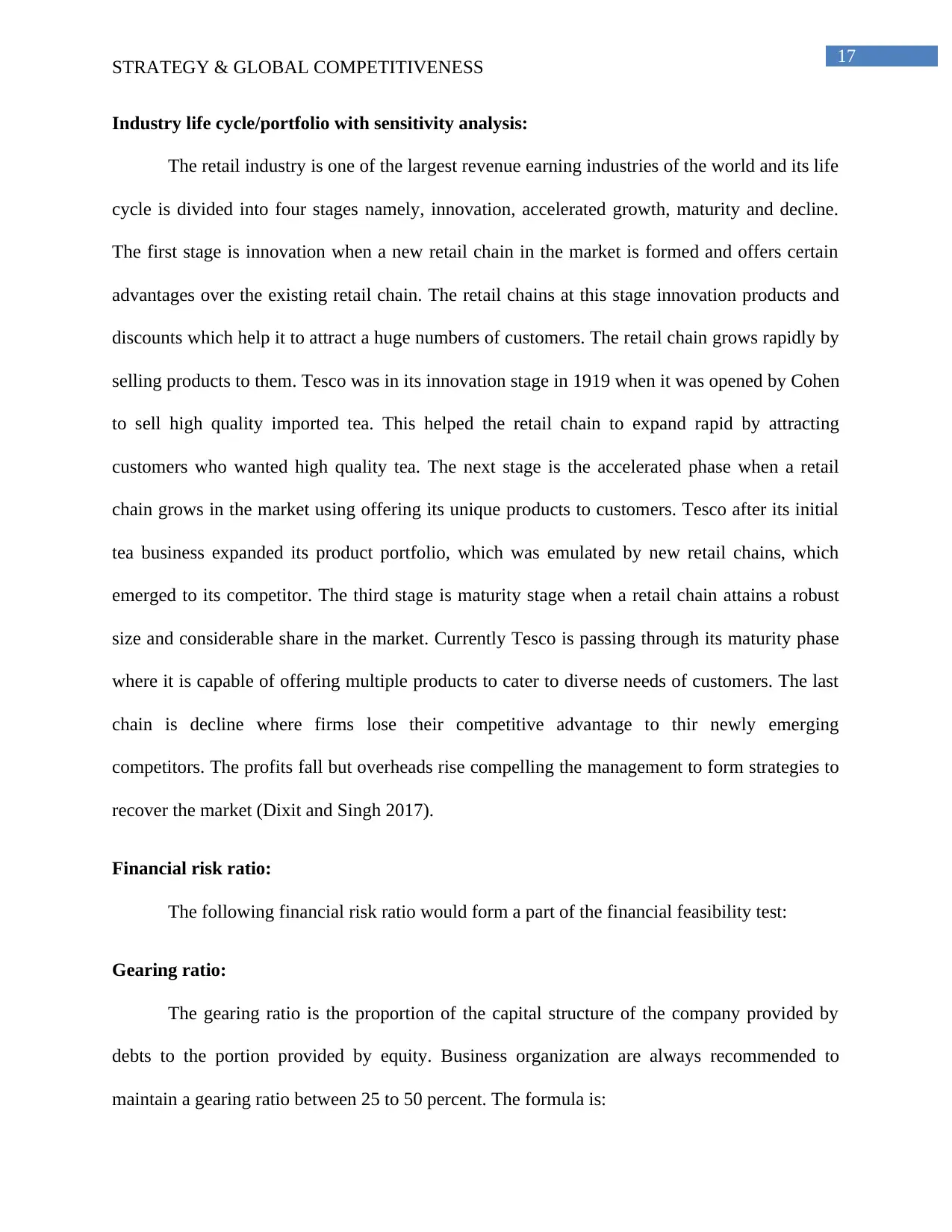
17
STRATEGY & GLOBAL COMPETITIVENESS
Industry life cycle/portfolio with sensitivity analysis:
The retail industry is one of the largest revenue earning industries of the world and its life
cycle is divided into four stages namely, innovation, accelerated growth, maturity and decline.
The first stage is innovation when a new retail chain in the market is formed and offers certain
advantages over the existing retail chain. The retail chains at this stage innovation products and
discounts which help it to attract a huge numbers of customers. The retail chain grows rapidly by
selling products to them. Tesco was in its innovation stage in 1919 when it was opened by Cohen
to sell high quality imported tea. This helped the retail chain to expand rapid by attracting
customers who wanted high quality tea. The next stage is the accelerated phase when a retail
chain grows in the market using offering its unique products to customers. Tesco after its initial
tea business expanded its product portfolio, which was emulated by new retail chains, which
emerged to its competitor. The third stage is maturity stage when a retail chain attains a robust
size and considerable share in the market. Currently Tesco is passing through its maturity phase
where it is capable of offering multiple products to cater to diverse needs of customers. The last
chain is decline where firms lose their competitive advantage to thir newly emerging
competitors. The profits fall but overheads rise compelling the management to form strategies to
recover the market (Dixit and Singh 2017).
Financial risk ratio:
The following financial risk ratio would form a part of the financial feasibility test:
Gearing ratio:
The gearing ratio is the proportion of the capital structure of the company provided by
debts to the portion provided by equity. Business organization are always recommended to
maintain a gearing ratio between 25 to 50 percent. The formula is:
STRATEGY & GLOBAL COMPETITIVENESS
Industry life cycle/portfolio with sensitivity analysis:
The retail industry is one of the largest revenue earning industries of the world and its life
cycle is divided into four stages namely, innovation, accelerated growth, maturity and decline.
The first stage is innovation when a new retail chain in the market is formed and offers certain
advantages over the existing retail chain. The retail chains at this stage innovation products and
discounts which help it to attract a huge numbers of customers. The retail chain grows rapidly by
selling products to them. Tesco was in its innovation stage in 1919 when it was opened by Cohen
to sell high quality imported tea. This helped the retail chain to expand rapid by attracting
customers who wanted high quality tea. The next stage is the accelerated phase when a retail
chain grows in the market using offering its unique products to customers. Tesco after its initial
tea business expanded its product portfolio, which was emulated by new retail chains, which
emerged to its competitor. The third stage is maturity stage when a retail chain attains a robust
size and considerable share in the market. Currently Tesco is passing through its maturity phase
where it is capable of offering multiple products to cater to diverse needs of customers. The last
chain is decline where firms lose their competitive advantage to thir newly emerging
competitors. The profits fall but overheads rise compelling the management to form strategies to
recover the market (Dixit and Singh 2017).
Financial risk ratio:
The following financial risk ratio would form a part of the financial feasibility test:
Gearing ratio:
The gearing ratio is the proportion of the capital structure of the company provided by
debts to the portion provided by equity. Business organization are always recommended to
maintain a gearing ratio between 25 to 50 percent. The formula is:
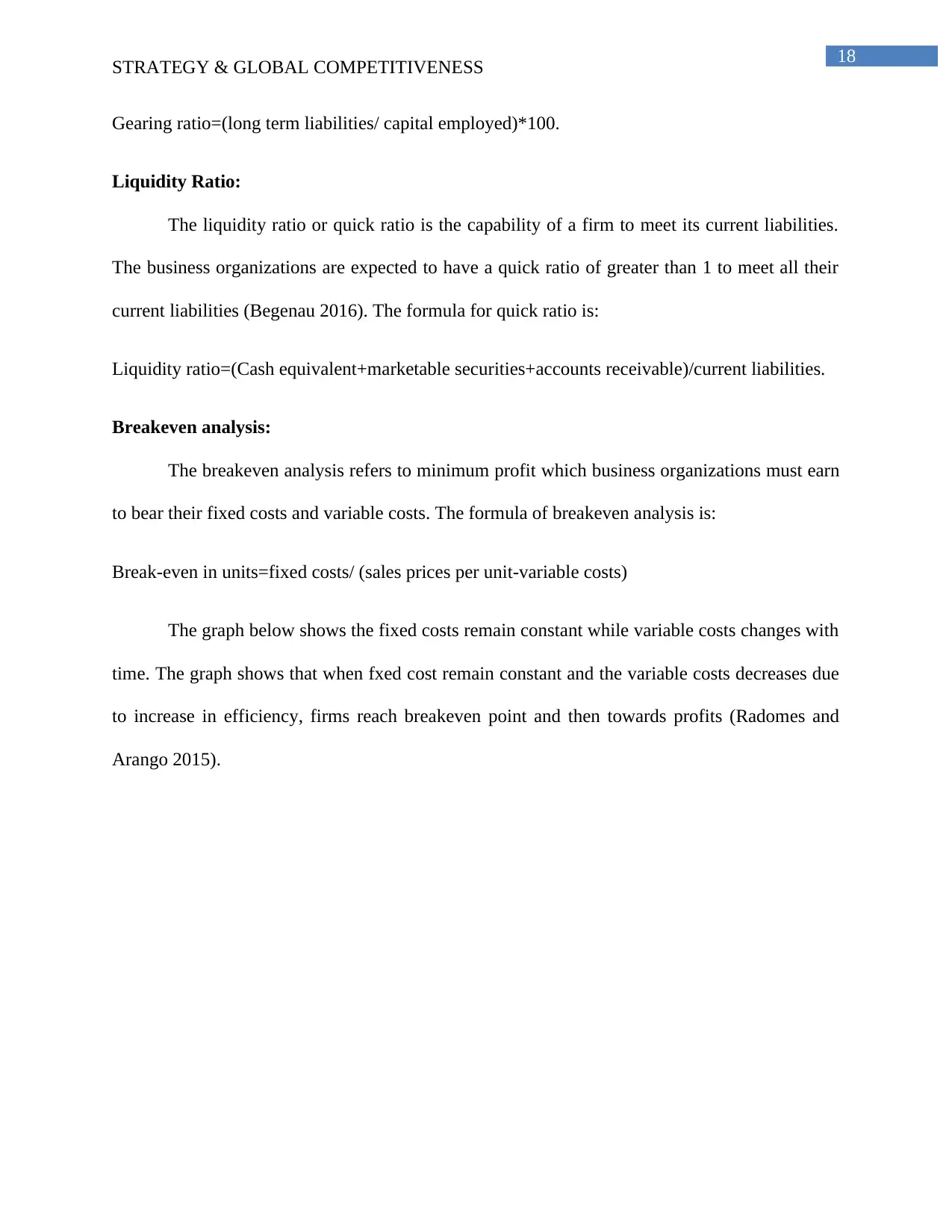
18
STRATEGY & GLOBAL COMPETITIVENESS
Gearing ratio=(long term liabilities/ capital employed)*100.
Liquidity Ratio:
The liquidity ratio or quick ratio is the capability of a firm to meet its current liabilities.
The business organizations are expected to have a quick ratio of greater than 1 to meet all their
current liabilities (Begenau 2016). The formula for quick ratio is:
Liquidity ratio=(Cash equivalent+marketable securities+accounts receivable)/current liabilities.
Breakeven analysis:
The breakeven analysis refers to minimum profit which business organizations must earn
to bear their fixed costs and variable costs. The formula of breakeven analysis is:
Break-even in units=fixed costs/ (sales prices per unit-variable costs)
The graph below shows the fixed costs remain constant while variable costs changes with
time. The graph shows that when fxed cost remain constant and the variable costs decreases due
to increase in efficiency, firms reach breakeven point and then towards profits (Radomes and
Arango 2015).
STRATEGY & GLOBAL COMPETITIVENESS
Gearing ratio=(long term liabilities/ capital employed)*100.
Liquidity Ratio:
The liquidity ratio or quick ratio is the capability of a firm to meet its current liabilities.
The business organizations are expected to have a quick ratio of greater than 1 to meet all their
current liabilities (Begenau 2016). The formula for quick ratio is:
Liquidity ratio=(Cash equivalent+marketable securities+accounts receivable)/current liabilities.
Breakeven analysis:
The breakeven analysis refers to minimum profit which business organizations must earn
to bear their fixed costs and variable costs. The formula of breakeven analysis is:
Break-even in units=fixed costs/ (sales prices per unit-variable costs)
The graph below shows the fixed costs remain constant while variable costs changes with
time. The graph shows that when fxed cost remain constant and the variable costs decreases due
to increase in efficiency, firms reach breakeven point and then towards profits (Radomes and
Arango 2015).
Paraphrase This Document
Need a fresh take? Get an instant paraphrase of this document with our AI Paraphraser
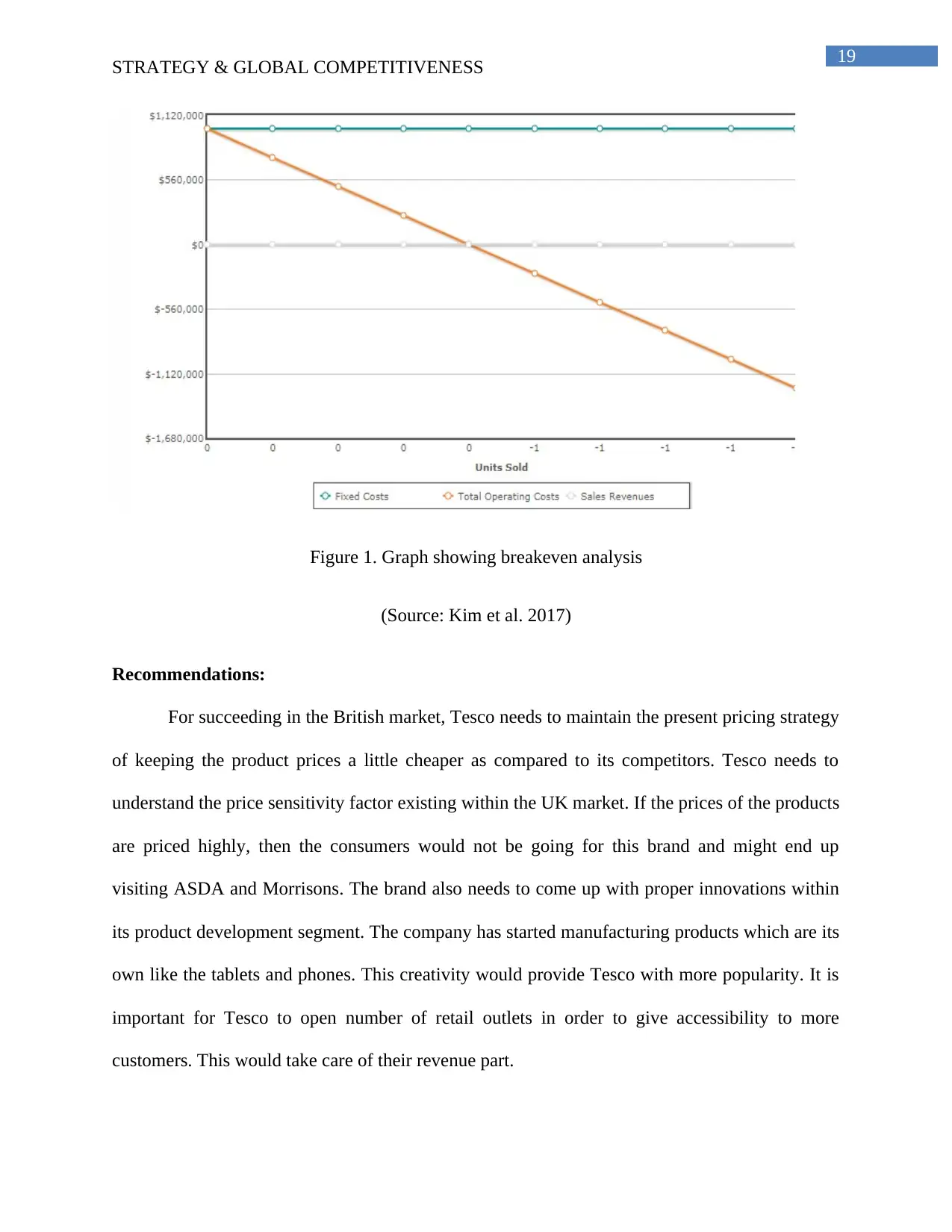
19
STRATEGY & GLOBAL COMPETITIVENESS
Figure 1. Graph showing breakeven analysis
(Source: Kim et al. 2017)
Recommendations:
For succeeding in the British market, Tesco needs to maintain the present pricing strategy
of keeping the product prices a little cheaper as compared to its competitors. Tesco needs to
understand the price sensitivity factor existing within the UK market. If the prices of the products
are priced highly, then the consumers would not be going for this brand and might end up
visiting ASDA and Morrisons. The brand also needs to come up with proper innovations within
its product development segment. The company has started manufacturing products which are its
own like the tablets and phones. This creativity would provide Tesco with more popularity. It is
important for Tesco to open number of retail outlets in order to give accessibility to more
customers. This would take care of their revenue part.
STRATEGY & GLOBAL COMPETITIVENESS
Figure 1. Graph showing breakeven analysis
(Source: Kim et al. 2017)
Recommendations:
For succeeding in the British market, Tesco needs to maintain the present pricing strategy
of keeping the product prices a little cheaper as compared to its competitors. Tesco needs to
understand the price sensitivity factor existing within the UK market. If the prices of the products
are priced highly, then the consumers would not be going for this brand and might end up
visiting ASDA and Morrisons. The brand also needs to come up with proper innovations within
its product development segment. The company has started manufacturing products which are its
own like the tablets and phones. This creativity would provide Tesco with more popularity. It is
important for Tesco to open number of retail outlets in order to give accessibility to more
customers. This would take care of their revenue part.
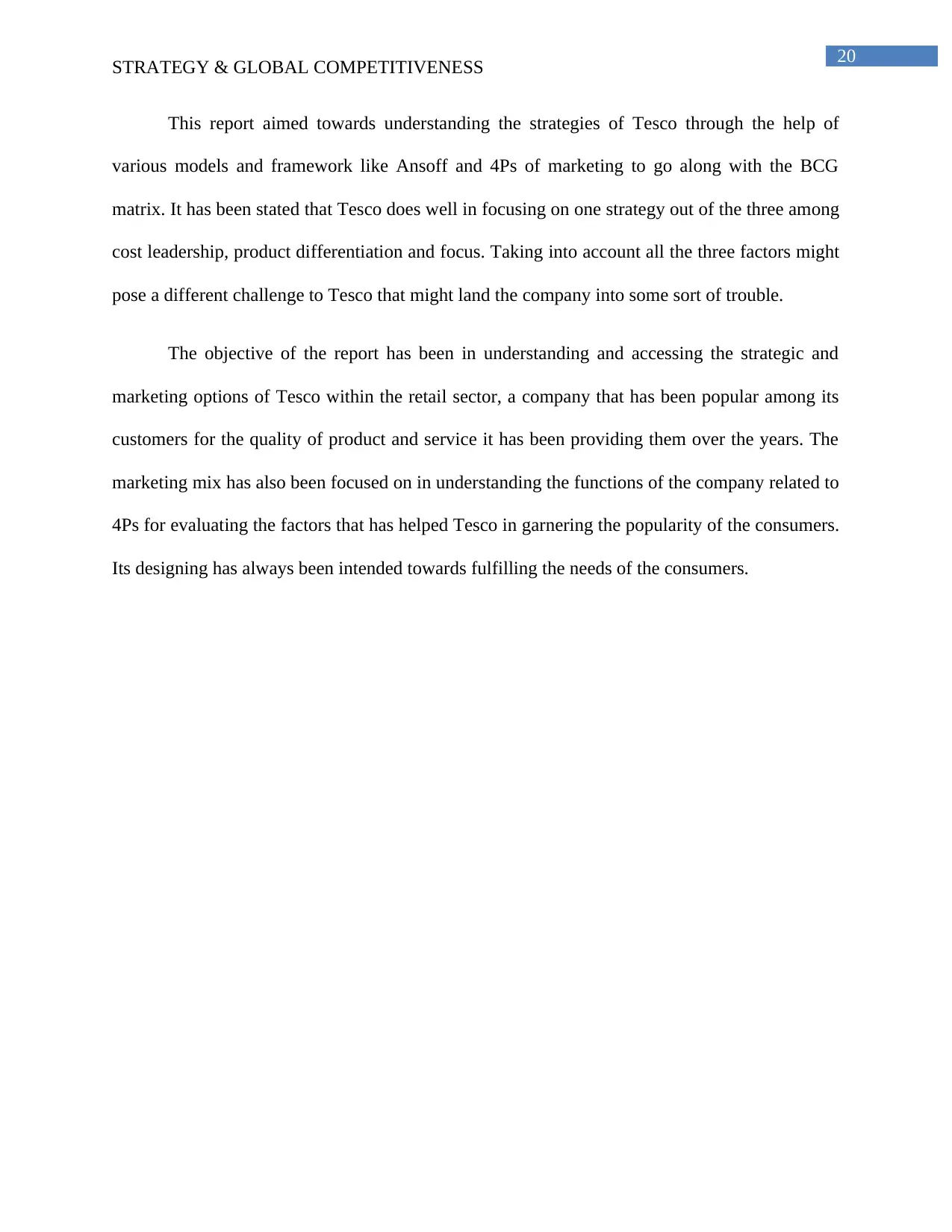
20
STRATEGY & GLOBAL COMPETITIVENESS
This report aimed towards understanding the strategies of Tesco through the help of
various models and framework like Ansoff and 4Ps of marketing to go along with the BCG
matrix. It has been stated that Tesco does well in focusing on one strategy out of the three among
cost leadership, product differentiation and focus. Taking into account all the three factors might
pose a different challenge to Tesco that might land the company into some sort of trouble.
The objective of the report has been in understanding and accessing the strategic and
marketing options of Tesco within the retail sector, a company that has been popular among its
customers for the quality of product and service it has been providing them over the years. The
marketing mix has also been focused on in understanding the functions of the company related to
4Ps for evaluating the factors that has helped Tesco in garnering the popularity of the consumers.
Its designing has always been intended towards fulfilling the needs of the consumers.
STRATEGY & GLOBAL COMPETITIVENESS
This report aimed towards understanding the strategies of Tesco through the help of
various models and framework like Ansoff and 4Ps of marketing to go along with the BCG
matrix. It has been stated that Tesco does well in focusing on one strategy out of the three among
cost leadership, product differentiation and focus. Taking into account all the three factors might
pose a different challenge to Tesco that might land the company into some sort of trouble.
The objective of the report has been in understanding and accessing the strategic and
marketing options of Tesco within the retail sector, a company that has been popular among its
customers for the quality of product and service it has been providing them over the years. The
marketing mix has also been focused on in understanding the functions of the company related to
4Ps for evaluating the factors that has helped Tesco in garnering the popularity of the consumers.
Its designing has always been intended towards fulfilling the needs of the consumers.
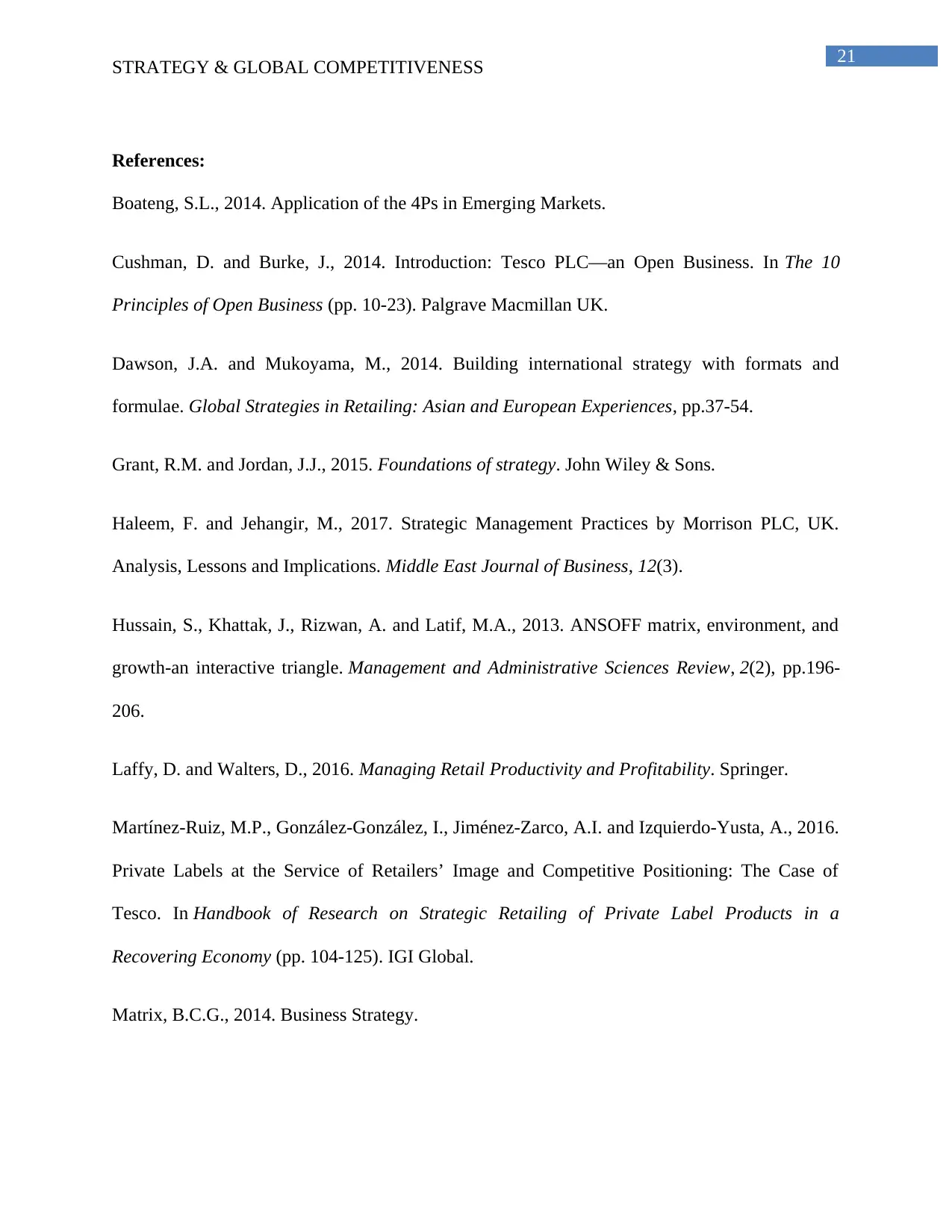
21
STRATEGY & GLOBAL COMPETITIVENESS
References:
Boateng, S.L., 2014. Application of the 4Ps in Emerging Markets.
Cushman, D. and Burke, J., 2014. Introduction: Tesco PLC—an Open Business. In The 10
Principles of Open Business (pp. 10-23). Palgrave Macmillan UK.
Dawson, J.A. and Mukoyama, M., 2014. Building international strategy with formats and
formulae. Global Strategies in Retailing: Asian and European Experiences, pp.37-54.
Grant, R.M. and Jordan, J.J., 2015. Foundations of strategy. John Wiley & Sons.
Haleem, F. and Jehangir, M., 2017. Strategic Management Practices by Morrison PLC, UK.
Analysis, Lessons and Implications. Middle East Journal of Business, 12(3).
Hussain, S., Khattak, J., Rizwan, A. and Latif, M.A., 2013. ANSOFF matrix, environment, and
growth-an interactive triangle. Management and Administrative Sciences Review, 2(2), pp.196-
206.
Laffy, D. and Walters, D., 2016. Managing Retail Productivity and Profitability. Springer.
Martínez-Ruiz, M.P., González-González, I., Jiménez-Zarco, A.I. and Izquierdo-Yusta, A., 2016.
Private Labels at the Service of Retailers’ Image and Competitive Positioning: The Case of
Tesco. In Handbook of Research on Strategic Retailing of Private Label Products in a
Recovering Economy (pp. 104-125). IGI Global.
Matrix, B.C.G., 2014. Business Strategy.
STRATEGY & GLOBAL COMPETITIVENESS
References:
Boateng, S.L., 2014. Application of the 4Ps in Emerging Markets.
Cushman, D. and Burke, J., 2014. Introduction: Tesco PLC—an Open Business. In The 10
Principles of Open Business (pp. 10-23). Palgrave Macmillan UK.
Dawson, J.A. and Mukoyama, M., 2014. Building international strategy with formats and
formulae. Global Strategies in Retailing: Asian and European Experiences, pp.37-54.
Grant, R.M. and Jordan, J.J., 2015. Foundations of strategy. John Wiley & Sons.
Haleem, F. and Jehangir, M., 2017. Strategic Management Practices by Morrison PLC, UK.
Analysis, Lessons and Implications. Middle East Journal of Business, 12(3).
Hussain, S., Khattak, J., Rizwan, A. and Latif, M.A., 2013. ANSOFF matrix, environment, and
growth-an interactive triangle. Management and Administrative Sciences Review, 2(2), pp.196-
206.
Laffy, D. and Walters, D., 2016. Managing Retail Productivity and Profitability. Springer.
Martínez-Ruiz, M.P., González-González, I., Jiménez-Zarco, A.I. and Izquierdo-Yusta, A., 2016.
Private Labels at the Service of Retailers’ Image and Competitive Positioning: The Case of
Tesco. In Handbook of Research on Strategic Retailing of Private Label Products in a
Recovering Economy (pp. 104-125). IGI Global.
Matrix, B.C.G., 2014. Business Strategy.
Secure Best Marks with AI Grader
Need help grading? Try our AI Grader for instant feedback on your assignments.
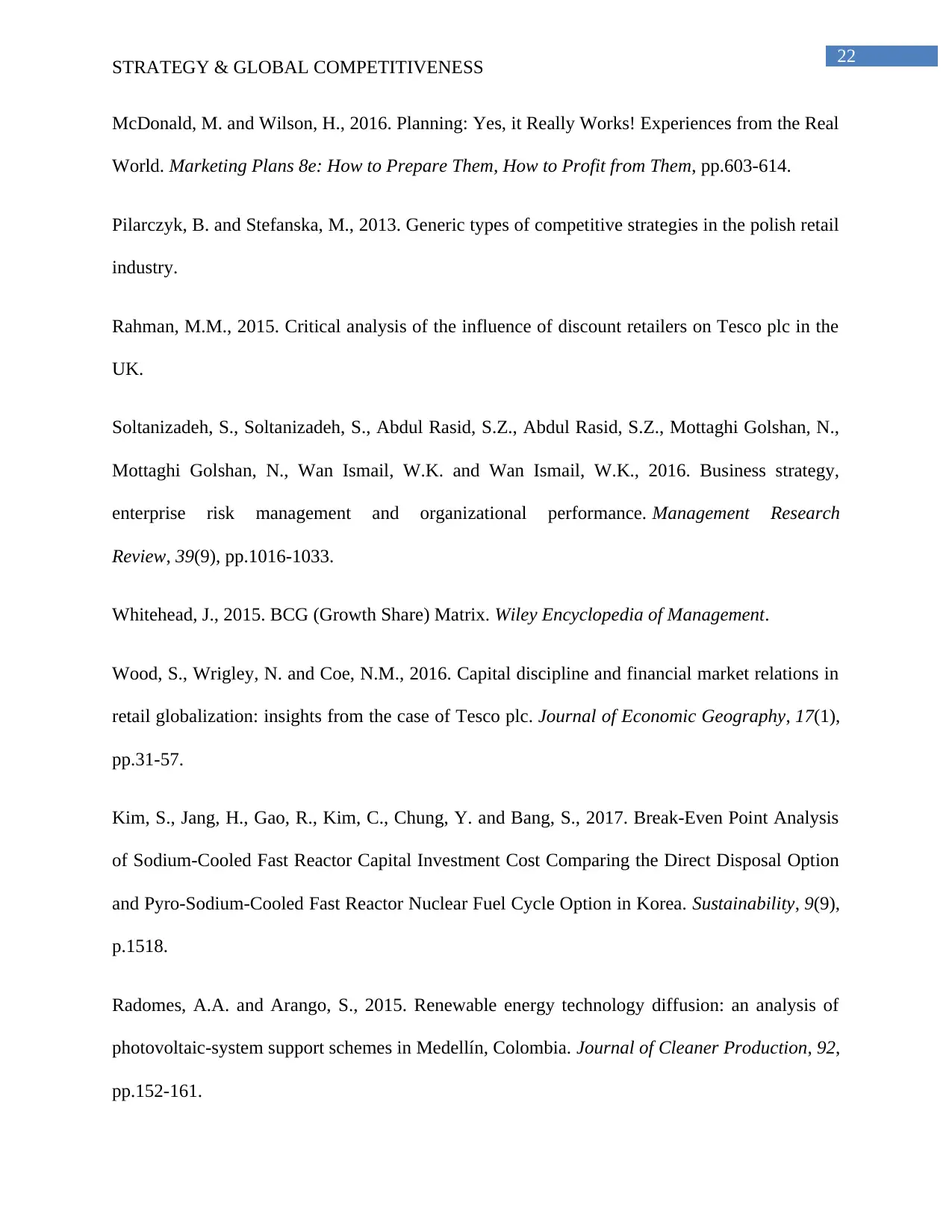
22
STRATEGY & GLOBAL COMPETITIVENESS
McDonald, M. and Wilson, H., 2016. Planning: Yes, it Really Works! Experiences from the Real
World. Marketing Plans 8e: How to Prepare Them, How to Profit from Them, pp.603-614.
Pilarczyk, B. and Stefanska, М., 2013. Generic types of competitive strategies in the polish retail
industry.
Rahman, M.M., 2015. Critical analysis of the influence of discount retailers on Tesco plc in the
UK.
Soltanizadeh, S., Soltanizadeh, S., Abdul Rasid, S.Z., Abdul Rasid, S.Z., Mottaghi Golshan, N.,
Mottaghi Golshan, N., Wan Ismail, W.K. and Wan Ismail, W.K., 2016. Business strategy,
enterprise risk management and organizational performance. Management Research
Review, 39(9), pp.1016-1033.
Whitehead, J., 2015. BCG (Growth Share) Matrix. Wiley Encyclopedia of Management.
Wood, S., Wrigley, N. and Coe, N.M., 2016. Capital discipline and financial market relations in
retail globalization: insights from the case of Tesco plc. Journal of Economic Geography, 17(1),
pp.31-57.
Kim, S., Jang, H., Gao, R., Kim, C., Chung, Y. and Bang, S., 2017. Break-Even Point Analysis
of Sodium-Cooled Fast Reactor Capital Investment Cost Comparing the Direct Disposal Option
and Pyro-Sodium-Cooled Fast Reactor Nuclear Fuel Cycle Option in Korea. Sustainability, 9(9),
p.1518.
Radomes, A.A. and Arango, S., 2015. Renewable energy technology diffusion: an analysis of
photovoltaic-system support schemes in Medellín, Colombia. Journal of Cleaner Production, 92,
pp.152-161.
STRATEGY & GLOBAL COMPETITIVENESS
McDonald, M. and Wilson, H., 2016. Planning: Yes, it Really Works! Experiences from the Real
World. Marketing Plans 8e: How to Prepare Them, How to Profit from Them, pp.603-614.
Pilarczyk, B. and Stefanska, М., 2013. Generic types of competitive strategies in the polish retail
industry.
Rahman, M.M., 2015. Critical analysis of the influence of discount retailers on Tesco plc in the
UK.
Soltanizadeh, S., Soltanizadeh, S., Abdul Rasid, S.Z., Abdul Rasid, S.Z., Mottaghi Golshan, N.,
Mottaghi Golshan, N., Wan Ismail, W.K. and Wan Ismail, W.K., 2016. Business strategy,
enterprise risk management and organizational performance. Management Research
Review, 39(9), pp.1016-1033.
Whitehead, J., 2015. BCG (Growth Share) Matrix. Wiley Encyclopedia of Management.
Wood, S., Wrigley, N. and Coe, N.M., 2016. Capital discipline and financial market relations in
retail globalization: insights from the case of Tesco plc. Journal of Economic Geography, 17(1),
pp.31-57.
Kim, S., Jang, H., Gao, R., Kim, C., Chung, Y. and Bang, S., 2017. Break-Even Point Analysis
of Sodium-Cooled Fast Reactor Capital Investment Cost Comparing the Direct Disposal Option
and Pyro-Sodium-Cooled Fast Reactor Nuclear Fuel Cycle Option in Korea. Sustainability, 9(9),
p.1518.
Radomes, A.A. and Arango, S., 2015. Renewable energy technology diffusion: an analysis of
photovoltaic-system support schemes in Medellín, Colombia. Journal of Cleaner Production, 92,
pp.152-161.
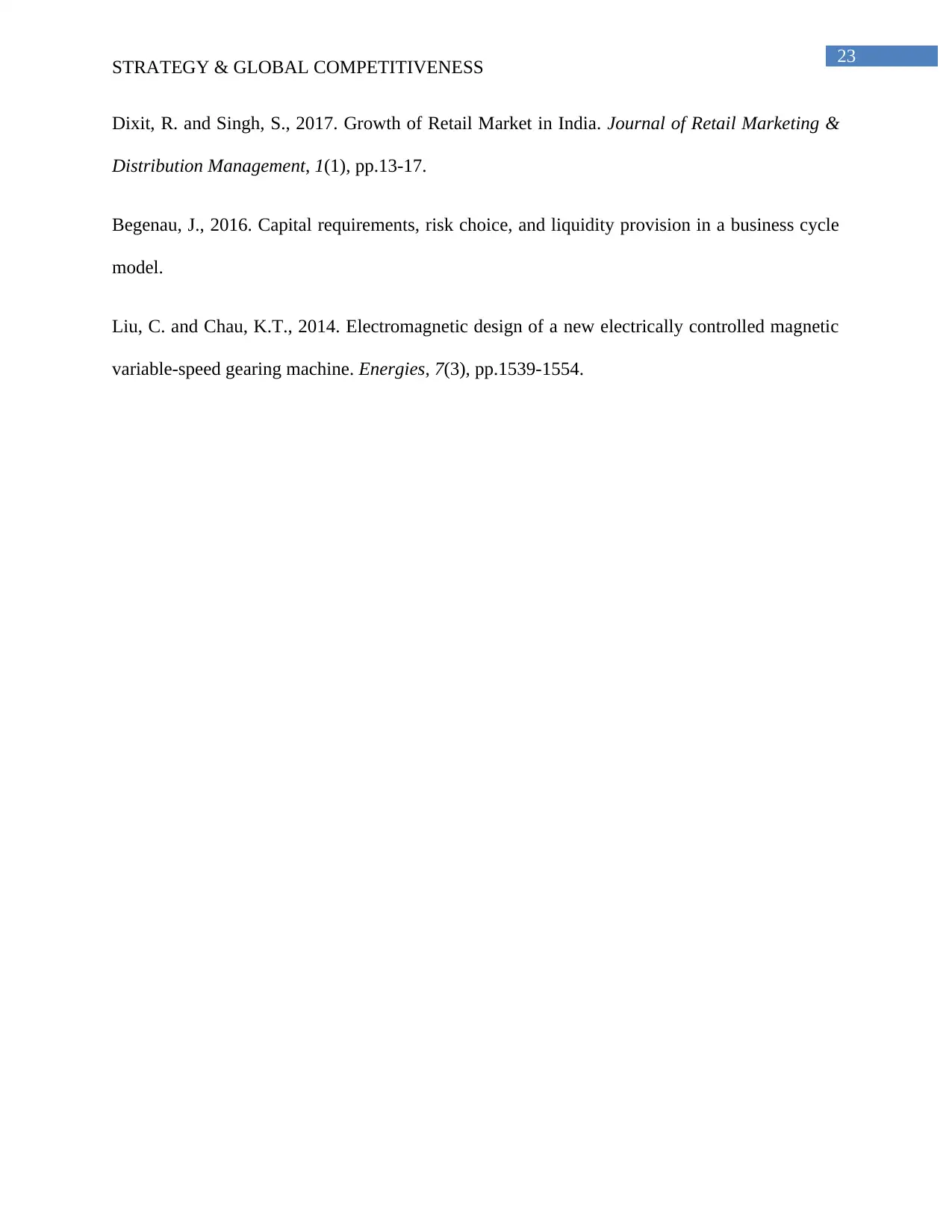
23
STRATEGY & GLOBAL COMPETITIVENESS
Dixit, R. and Singh, S., 2017. Growth of Retail Market in India. Journal of Retail Marketing &
Distribution Management, 1(1), pp.13-17.
Begenau, J., 2016. Capital requirements, risk choice, and liquidity provision in a business cycle
model.
Liu, C. and Chau, K.T., 2014. Electromagnetic design of a new electrically controlled magnetic
variable-speed gearing machine. Energies, 7(3), pp.1539-1554.
STRATEGY & GLOBAL COMPETITIVENESS
Dixit, R. and Singh, S., 2017. Growth of Retail Market in India. Journal of Retail Marketing &
Distribution Management, 1(1), pp.13-17.
Begenau, J., 2016. Capital requirements, risk choice, and liquidity provision in a business cycle
model.
Liu, C. and Chau, K.T., 2014. Electromagnetic design of a new electrically controlled magnetic
variable-speed gearing machine. Energies, 7(3), pp.1539-1554.
1 out of 24
Related Documents
Your All-in-One AI-Powered Toolkit for Academic Success.
+13062052269
info@desklib.com
Available 24*7 on WhatsApp / Email
![[object Object]](/_next/static/media/star-bottom.7253800d.svg)
Unlock your academic potential
© 2024 | Zucol Services PVT LTD | All rights reserved.





